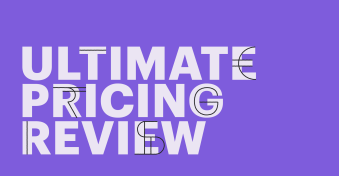When you’re sending digital documents, capturing a valid e-signature can be critical to your business’s success, and DocuSign (formerly DocuSign) or Docusign alternatives can be a godsend.
Without an efficient signing solution helping you capture legally binding electronic signatures, you could be exposing your organization to legal troubles down the road.
Docusign can be a great starting point for businesses just getting on board with digital signatures.
At $10 per month, it’s a low-risk way to send a few documents per month while getting a feel for how e-signing actually works.
But Docusign isn’t the only choice out there.
You’ll find a number of digital signature solutions on the market. We’ve narrowed it down to what we feel are the best of the best.
Here are a few Docusign alternatives to help you get started.
Key takeaways
- The e-signature market is flush with Docusign competitors, many of whom offer great signing experiences.
- Many DocuSign alternatives offer better usage limits, competitive pricing, and/or advanced features as part of their standard packages.
- Several modern solutions combine e-signing with another major feature, like document editing or cloud storage, as a way to differentiate themselves.
Why look for a Docusign alternative?
Docusign is a valuable tool if you need a way to send and sign your forms and contracts.
It’s equipped with the industry standard toolkit for e-signing, including real-time audit trails, template creation, customized branding, and more.
But, while Docusign is useful, it’s also very limited in scope.
In many ways, Docusign defined much of the modern and current industry standards around e-signing.
In order to maintain the standards around such a niche product, DocuSign can’t add a kitchen sink of features to their e-signing platform.
Instead, the company offers tools like DocuSign CLM and DocuSign Gen for Salesforce as separate products that fall outside the scope of traditional e-signing.
This gives other brands the opportunity to offer more sophisticated e-signing solutions and features at lower costs.
Here’s a closer look at why you might want to consider one of DocuSign’s competitors.
Better tools
Right now, there are software tools on the market that offer as much or more than Docusign offers for an equivalent cost.
In addition to e-signing, other solutions similar to DocuSign might offer extra features that allow you to create and send better documents.
That could be something as simple as removing the transaction limits imposed by DocuSign or something more robust, like advanced document tracking and analytics analysis.
And the best part? Many of the alternative solutions to DocuSign aren’t more expensive.
You could end up paying the same and end up with even more tools at your disposal!
Better workflow
Docusign does one thing — electronic signing — really well, but they leave it to you to handle other parts of the document lifecycle process on your own.
While we can all agree that doing one thing well is better than doing a lot of things poorly, that’s not what we see with current DocuSign alternatives.
Many of today’s document management platforms actually fold electronic signature capture into one part of a document workflow that handles everything from document creation all the way to document storage and retrieval.
In this scenario, tools like Docusign house a storage and document preparation interface while also acting as an e-signing platform.
So, why does this matter?
Because users who want to streamline their document workflow can benefit by switching to tools that offer a greater selection of management features.
Rather than leveraging multiple tools to create and manage documents, you could be creating, sending, signing, and storing all of your documents in one place.
For teams looking to improve productivity, a centralized workflow is a proven way to boost those numbers.
Better service
One of the biggest gripes we see about Docusign is the service.
Most of the time, nothing goes wrong. But when it does, it can take days for someone to get back to you.
Of course, you can always buy the extra support package — but is advanced support something that you should really have to pay for to get questions answered in a timely manner?
Many Docusign competitors offer better pricing and availability around support (sometimes, it’s even around the clock!) so that you can get your problem solved and keep working.
Docusign alternatives overview
The table below offers a broad overview of each software so you can get a better idea of how they compare.
| Software | At a glance | Pricing |
| PandaDoc | An all-in-one document management platform with powerful eSignature capabilities, approvals, automation, and payments—all in one platform. | Starts at $19/user/month |
| Dropbox Sign | Simple and intuitive solution that integrates with Dropbox for seamless file management and signing. | Starts at $15/user/month |
| SignNow | Easy-to-use and affordable eSignature tool with bulk sending and API access, great for businesses. | Starts at $8/user/month (business) |
| Adobe Sign | Offers enterprise-grade security and compliance for eSignatures and works seamlessly within Adobe Document Cloud. | Starts at $14.99/month per license |
| Sharefile Premium | Integrates secure file sharing with unlimited eSignatures and powerful workflow automation. | Starts at $25/month |
| SignRequest | Simple, lightweight, and budget-friendly for everything you need, with a focus on GDPR compliance. | Starts at $9/user/month |
| Signeasy | A mobile-friendly platform designed for remote individuals and teams. | Starts at $10/user/month |
| OneSpan Sign | Offers advanced authentication and fraud prevention, best for highly regulated industries. | Starts at $22/month |
| eSignly | Features top-notch security and is cloud-based, plus it offers a free plan with unlimited document signing for individuals. | Free plan available; paid plans start at $10/month |
| Xodo Sign | Formerly “eversign,” now a highly flexible solution that focuses on API integrations. | Free plan available; paid plans start at $9.99/month |
| Foxit eSign | Meant for businesses that often work with PDFs and need a strong signing workflow. | Starts at $10/month |
| YouSign | Based in Europe, this solution has eIDAS compliance for digital signatures. | Starts at $8/user/month |
| Formstack Sign | A solution that simplifies eSignature workflows as part of a no-code automation suite. | Starts at $83/user/month |
| GetAccept | Ideal for sales teams with a need for real-time document tracking and video messaging. | Starts at $25/user/month (essential) |
| DocSend | Excels in document control, analytics, and secure file sharing for businesses. | Starts at $10/user/month |
| DottedSign | Fast and user-friendly and offers AI-assisted signing suggestions. | Free plan available; paid plans start at $8/user/month |
| CocoSign | Has a strong focus on security, powerful encryption, and audit trails for compliance. | Free plan available; paid plans start at $8/user/month |
| Signaturely | Simple interface designed for small businesses and freelancers. | Starts at $25/user/month |
Now let’s learn more about these Docusign alternatives.
1. PandaDoc
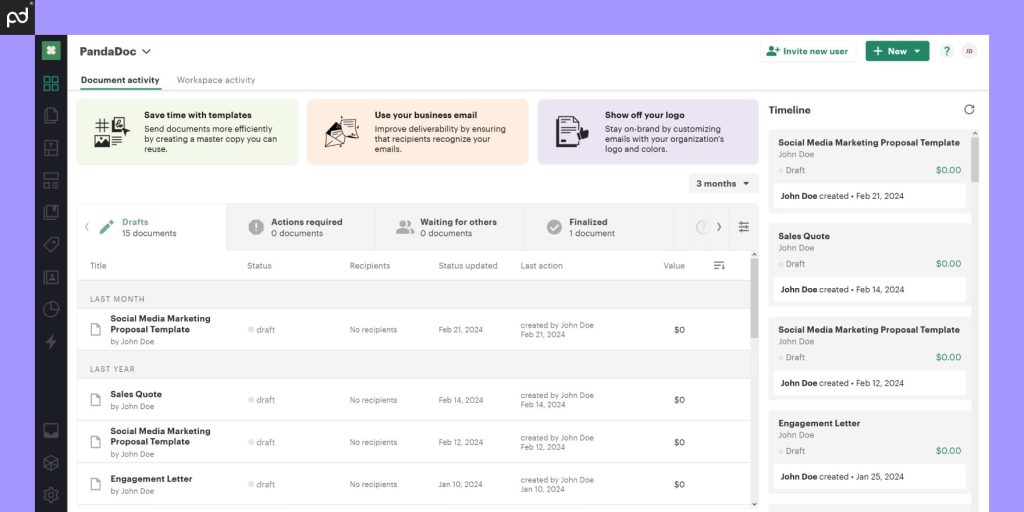
Cost: Starter ($19); Business ($49); Enterprise plans available.
Pricing based on monthly rate per single user.
Platform availability: Web (all devices); mobile app (iOS/Android).
Free trial: Yes; 14 days.
| Plan Details | Docusign | PandaDoc Business |
|---|---|---|
| Plan Name | Business Pro | Business |
| Maximum seats on plan | 50 | Unlimited |
| Minimum seats on plan | – | – |
| Monthly rate (per month/user) | $65 | $49 |
| Annual rate (per month/user) | $40 | $49 |
| Transaction limits (per user) | 100/year | Unlimited |
| Core product | ||
| eSignature capture | ✓ | ✓ |
| Real-time audit trail | ✓ | ✓ |
| Notifications | ✓ | ✓ |
| Language support | ✓ | ✓ |
| Mobile app | ✓ | ✓ |
| Reporting tools | ✓ | ✓ |
| eSigning features | ||
| Signing order | ✓ | ✓ |
| Send to multiple recipients | ✓ | ✓ |
| Bulk send | ✓ | Enterprise feature; customer pricing available |
| In-person signing | ✓ | ✓ |
| Collaboration tools | ✓ | ✓ |
| Signer attachments | ✓ | X |
| Payment gateway | ✓ | ✓ |
| Document prep | ||
| Drag & drop fields (PDF) | ✓ | ✓ |
| Create reusable templates | ✓ | ✓ |
| From-scratch document builder | X | ✓ |
| Pre-built template library | X | ✓ |
| Form creation | ✓ | $ |
| Custom branding | ✓ | ✓ |
| Integrations & API | ||
| Import & storage | ✓ | ✓ |
| CRM Integration | X | ✓ |
| Productivity | ✓ | ✓ |
| API | $ | Enterprise feature; custom pricing available |
| Support | ||
| Email / ticketing support | ✓ | ✓ |
| Chat support | X | ✓ |
| Knowledge base | ✓ | ✓ |
| Phone | X | X |
| Premium support options | $ | $ |
Key features
- Unparalleled document and form creation using the PandaDoc document editor.
- Powerful analytics and tracking tools to let you know when and how long someone reviewed your document.
- Secure electronic signature and payment capture for legally binding contracts and secure transactions.
We might be biased, but we feel that PandaDoc is the most powerful DocuSign alternative on the list.
PandaDoc is a document platform designed to handle everything from electronic signatures to document management.
We offer affordable pricing that scales with your business, making this a great fit for organizations of any size.
In addition to powerful custom branding and e-signature solutions, PandaDoc comes equipped with a unique document editor to help you create business documents from scratch and automate your entire workflow.
The platform also offers 1000+ starter templates to help you jumpstart your document library.
PandaDoc users can also use both native and Zapier integrations to connect PandaDoc to your favorite services, from Google Drive and Dropbox all the way to Salesforce, HubSpot, Zoho, and other leading CRMs.
You can even connect your document process to the rest of your tech stack by integrating with apps like Slack, Microsoft Teams, or Google Sheets.
Along with email support and an extensive product knowledge base, PandaDoc offers live chat support so you can ask questions and get answers when you need them most.
Why switch to PandaDoc?
If you’re looking for the best alternative to DocuSign, PandaDoc will be most attractive for its all-in-one approach to document creation.
You can write everything in the document editor, format your documents for signing, and then save them as flexible, customizable templates to speed up the process next time.
You don’t need to use Google Docs or Microsoft Word when creating your contracts. (But you can! We offer native integrations for both Word Online and Workspace.)
We also offer storage for all your signed documents.
Keeping these files within PandaDoc makes it easy to renew contracts and locate old paperwork when it’s time to review.
It’s a huge step in the right direction for both small businesses and enterprise teams who want to automate sales processes.
Not interested in document creation?
Upload existing contract templates to PandaDoc and use our e-signature tool for authentication and expedited signing.
As an e-sign vendor PandaDoc is as good as DocuSign for ease of use, security, HIPAA compliance, and more.
But don’t take our word for it. See for yourself with a product demo or a 14-day trial.
2. Dropbox Sign
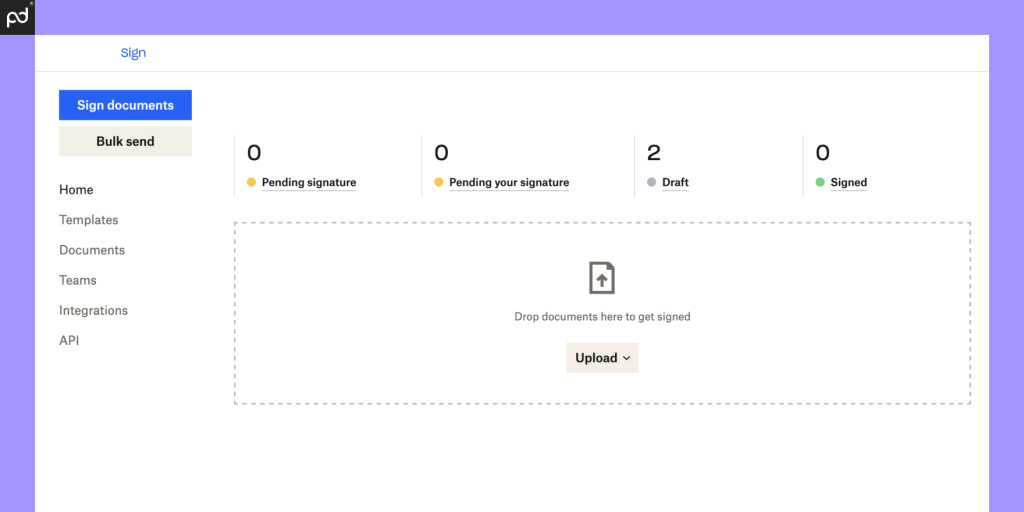
Cost: Essentials ($20); Standard ($60); Enterprise plans available. Pricing based on minimum monthly seat requirements.
Platform availability: Web (all devices); mobile app (iOS/Android).
Free trial: Yes; 30 days.
| Plan Details | DocuSign | Dropbox Sign |
|---|---|---|
| Plan Name | Business Pro | Standard |
| Maximum seats on plan | 50 | Unlimited |
| Minimum seats on plan | – | 2 |
| Monthly rate (per month/user) | $65 | $60 |
| Annual rate (per month/user) | $40 | $50 |
| Transaction limits (per user) | 100/year | Unlimited |
| Core product | ||
| E-signature capture | ✓ | ✓ |
| Real-time audit trail | ✓ | ✓ |
| Notifications | ✓ | ✓ |
| Language support | ✓ | ✓ |
| Mobile app | ✓ | ✓ |
| Reporting tools | ✓ | ✓ |
| E-signing features | ||
| Signing order | ✓ | ✓ |
| Send to multiple recipients | ✓ | ✓ |
| Bulk send | ✓ | ✓ |
| In-person signing | ✓ | ✓ |
| Collaboration tools | ✓ | ✓ |
| Signer attachments | ✓ | ✓ |
| Payment gateway | ✓ | X |
| Document prep | ||
| Drag & drop fields (PDF) | ✓ | ✓ |
| Create reusable templates | ✓ | 15 |
| From-scratch document builder | X | X |
| Pre-built template library | X | X |
| Form creation | ✓ | X |
| Custom branding | ✓ | X |
| Integrations & API | ||
| Import & storage | ✓ | ✓ |
| CRM | X | ✓ |
| Productivity | ✓ | ✓ |
| API | $ | X |
| Support | ||
| Email / ticketing support | ✓ | ✓ |
| Chat support | X | X |
| Knowledge base | ✓ | ✓ |
| Phone | X | X |
| Premium support options | $ | $ |
Key features
- Offers strong signing solutions and automated workflows for fast and easy signature capture.
- Part of the Dropbox family of apps.
- Provides key storage and CRM integrations early, without requiring enterprise-level subscriptions.
Dropbox Sign (formerly HelloSign) is a simple and straightforward way to capture legally-binding e-signatures.
As with many services like DocuSign, Dropbox Sign integrates seamlessly with Dropbox, as well as Google and other major platforms, to create a signature solution that is simple and easy to use.
Like DocuSign, Dropbox Sign offers template creation options and custom branding solutions, as well as team management tools, for its enterprise plans.
However, unlike PandaDoc, Dropbox Sign doesn’t offer a document editor or any kind of robust document creation tool. It’s strictly a signing platform, similar to DocuSign.
If you need document creation tools, you can work around this limitation (somewhat) by using integrations and plug-ins to connect Dropbox Sign to Google Docs so that the signing tools are available to you while creating your documents.
However, it’s not a seamless solution.
As a DocuSign alternative, Dropbox Sign wins points for ease of use and seamless Google Docs integration.
The user interface is unobtrusive and does a great job of staying out of the way so that you can streamline your signing process.
Continue using the tools you’ve always used and use Dropbox Sign to insert signatures into live documents (including PDFs) whenever and wherever you need them.
All that said, Dropbox Sign currently finds itself in a strange place.
This platform is still available as a standalone option, but most standard Dropbox (storage) subscription plans now include native e-signing options.
From what we’ve been able to tell, Dropbox Sign tends to offer better solutions for teams who need reporting tools and integrations.
The e-signing included with the storage plans appears to offer an abbreviated feature set, but it’s unclear how much functionality is shared between these plans.
3. SignNow
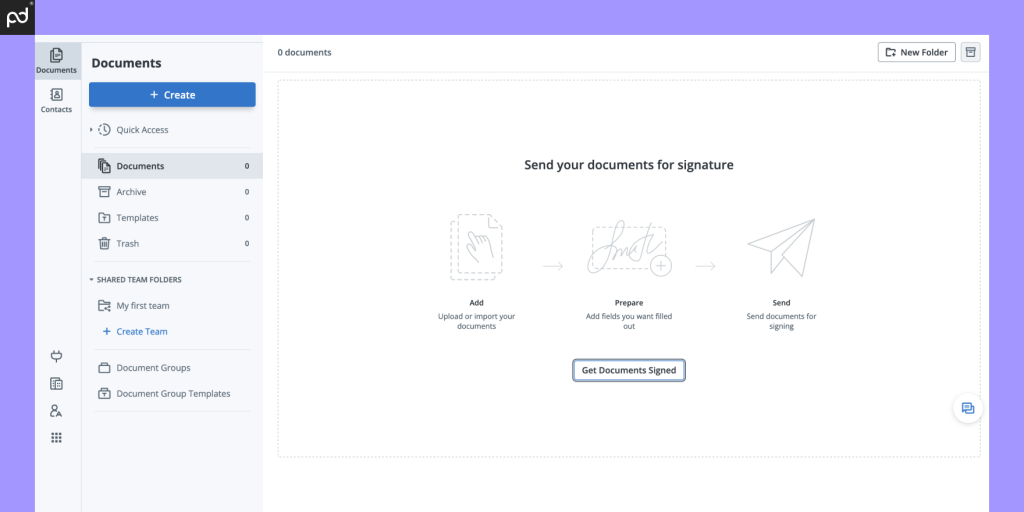
Cost: Business ($20); Business Premium ($30); Enterprise ($50); Business Cloud ($250, incl. five seats). Pricing based on minimum monthly seat requirements.
Platform availability: Web (all devices); mobile app (iOS/Android).
Free trial: Yes.
| Plan Details | DocuSign | SignNow |
|---|---|---|
| Plan Name | Business Pro | Enterprise |
| Maximum seats on plan | 50 | Unlimited |
| Minimum seat on plan | – | – |
| Monthly rate (per month/user) | $65 | $50 |
| Annual rate (per month/user) | $40 | $30 |
| Transaction limits (per user) | 100 docs/year | Unlimited |
| Core product | ||
| E-signature capture | ✓ | ✓ |
| Real-time audit trail | ✓ | ✓ |
| Notifications | ✓ | ✓ |
| Language support | ✓ | ✓ |
| Mobile app | ✓ | ✓ |
| Reporting tools | ✓ | ✓ |
| E-signing features | ||
| Signing order | ✓ | ✓ |
| Send to multiple recipients | ✓ | ✓ |
| Bulk send | ✓ | ✓ |
| In-person signing | ✓ | ✓ |
| Collaboration tools | ✓ | Limited |
| Signer attachments | ✓ | ✓ |
| Payment gateway | ✓ | ✓ |
| Document prep | ||
| Drag & drop fields (PDF) | ✓ | ✓ |
| Create reusable templates | ✓ | ✓ |
| From-scratch document builder | X | X |
| Pre-built template library | X | X |
| Form creation | ✓ | ✓ |
| Custom branding | ✓ | ✓ |
| Integrations & API | ||
| Import & storage | ✓ | ✓ |
| CRM | X | X |
| Productivity | ✓ | Limited |
| API | $ | X |
| Support | ||
| Email / ticketing support | ✓ | ✓ |
| Chat support | X | ✓ |
| Knowledge base | ✓ | ✓ |
| Phone | X | X |
| Premium support options | $ | X |
Key features
- Superior pricing versus DocuSign for electronic signature send and capture.
- Comes with onboard document generation (not from-scratch creation) tools to help you compile documents quickly.
- Access to features like bulk sending and branding tools are available at lower pricing tiers and for a lower cost.
Most platforms like DocuSign are industry agnostic and can fit into companies of any size, and SignNow is no exception.
While it’s part of the airSlate family of products, SignNow offers competitive solutions for teams of all sizes.
Price is one of the big selling points for SignNow.
When billed annually, SignNow offers annual subscriptions as low as $8/month for a Business plan or $15/month for a Premium plan.
Even their month-to-month subscription rates are competitive with similar products.
The low cost makes SignNow an obvious choice for companies looking to keep overhead low when switching away from DocuSign.
The platform also offers a wide variety of features, including custom branding, bulk sending, and document variables that other companies only offer at a higher cost.
A key feature with the SignNow platform is document generation — but it doesn’t work like the PandaDoc editor, Google Docs, or Microsoft Word.
Instead, you’ll create a template from a DOCX or PDF file by adding tags and fillable fields to your uploaded document. (In PandaDoc, we call them variables.)
After that, you’ll need to connect your template to a dataset. Once you’ve mapped the data to the tag, SignNow will automatically replace the tag with data from your source.
This method provides a high level of automation, but document formatting and customization need to be handled elsewhere.
After your template is built and tagged, generating documents is straightforward … so long as you don’t need to make format changes!
Like Dropbox Sign, SignNow integrates well with major document management and creation platforms so that you can use it with the tools you already have.
As far as support options go, live chat support is available on every plan. Only Enterprise-level subscribers receive phone support.
4. Adobe Acrobat Sign
![An Image Of The Acrobat Sign] User Interface And Primary Dashboard](https://public-site.marketing.pandadoc-static.com/app/uploads/sites/3/BP_docusign-alternatives_4-1-1024x720-1.png)
Cost: Acrobat Standard for teams ($180); Acrobat Pro for teams ($288). Price per single user. Annual commitment required. Individual and Enterprise plans also available.
Platform availability: Web (all devices); mobile app (iOS/Android).
Free trial: Yes: 14 days.
| Plan Details | DocuSign | Adobe Acrobat Sign |
|---|---|---|
| Plan Name | Business Pro | Acrobat Pro for Team |
| Maximum seats on plan | 50 | 250 |
| Minimum seat on plan | – | – |
| Monthly rate (per month/user) | $65 | – |
| Annual rate (per month/user) | $40 | $24 |
| Transaction limits (per user) | 100 docs/year | 150 |
| Core product | ||
| E-signature capture | ✓ | ✓ |
| Real-time audit trail | ✓ | ✓ |
| Notifications | ✓ | ✓ |
| Language support | ✓ | ✓ |
| Mobile app | ✓ | ✓ |
| Reporting tools | ✓ | ✓ |
| E-signing features | ||
| Signing order | ✓ | ✓ |
| Send to multiple recipients | ✓ | ✓ |
| Bulk send | ✓ | ✓ |
| In-person signing | ✓ | X |
| Collaboration tools | ✓ | ✓ |
| Signer attachments | ✓ | ✓ |
| Payment gateway | ✓ | ✓ |
| Document prep | ||
| Drag & drop fields (PDF) | ✓ | ✓ |
| Create reusable templates | ✓ | ✓ |
| From-scratch document builder | X | X |
| Pre-built template library | X | X |
| Form creation | ✓ | ✓ |
| Custom branding | ✓ | ✓ |
| Integrations & API | ||
| Import & storage | ✓ | ✓ |
| CRM | X | ✓ |
| Productivity | ✓ | ✓ |
| API | $ | X |
| Support | ||
| Email / ticketing support | ✓ | ✓ |
| Chat support | X | X |
| Knowledge base | ✓ | ✓ |
| Phone | X | ✓ |
| Premium support options | $ | $ |
Key features
- Native PDF editing tools allow for advanced customization when editing documents that would be unalterable on DocuSign and other platforms.
- Limited to 150 transactions per user/year compared to DocuSign’s 100 per user/year limit.
- Broad plan selection for additional customization; annual-only subscriptions are mandatory for team plans.
As part of the Adobe family of apps, you can expect Acrobat Sign (formerly Adobe Sign)to work well with most other business-related tools you’ll see on the market today.
Like most of the other apps on our list, Acrobat Sign uses an online, cloud-based system to sign and send documents.
You’ll upload your documents to the platform and make changes to them as you move through the signing workflow.
Acrobat Sign’s most unique feature is its live editing capabilities for PDFs. Every other signing platform we’ve reviewed only allows for limited modification of PDF documents.
Users can add signing fields, text boxes, date fields, etc. With Acrobat Sign, you can make live edits to PDFs, as though it were a Word or Google Docs file.
Of course, while Adobe offers tremendous flexibility with PDF editing, the editor isn’t designed for from-scratch document creation like the PandaDoc editor.
Even so, you’ll still be able to capture legally binding e-signatures and create comprehensive audit trails.
You’ll also have access to integrations, APIs, payment collection options, and branding tools on higher-tiered plans.
Additionally, Adobe offers a variety of premium support options for teams who need it.
When compared to DocuSign, Acrobat Sign can be a game-changer.
All that said, there are a few drawbacks to Acrobat Sign: While Adobe will help you capture legally binding e-signatures, the company points out that the level of e-signature compliance varies based on the plan you purchase.
What does that mean?
Simply put: For any plan short of Adobe’s enterprise-level plan (actually called “Acrobat Sign”) the technology provided for signature capture may be insufficient for certain forms of compliance or legal scrutiny.
All other Acrobat plans — Standard, Pro, “for teams”, etc. — won’t receive the same level of compliance.
This isn’t an issue for most signers, but it’s worth checking into if you have specific legal requirements surrounding the digital signatures you need to acquire.
Other major considerations include the plan selection and transaction limits.
Adobe plans are limited to 150 transactions per user/year, up 50% from DocuSign’s 100-transaction limit.
This cap may feel limiting if you need to send a large number of documents throughout the year.
If that’s the case, choosing a provider with unlimited sending limits like PandaDoc or Dropbox Sign might be a better option.
Regarding plans: We’ve noted the cost of the team plans above, but Adobe also offers individual plans at a slightly lower cost.
If you’re a solo user or part of a small team, it might be worth evaluating those options before you commit to a team plan.
5. Sharefile Premium (formerly RightSignature)

Cost: Sharefile Premium ($82.50, incl. 3 seats). Pricing based on minimum monthly seat requirements. Other Sharefile plans available, but none offer e-signing.
Platform availability: Web (all devices).
Free trial: Yes; 30 days.
| Plan Details | DocuSign | Sharefile |
|---|---|---|
| Plan Name | Business Pro | Premium |
| Maximum seats on plan | 50 | – |
| Minimum seat on plan | – | 3 |
| Monthly rate (per month/user) | $65 | $82.50 |
| Annual rate (per month/user) | $40 | $75 |
| Transaction limits (per user) | 100 docs/year | Unlimited |
| Core product | ||
| E-signature capture | ✓ | ✓ |
| Real-time audit trail | ✓ | ✓ |
| Notifications | ✓ | ✓ |
| Language support | ✓ | X |
| Mobile app | ✓ | X |
| Reporting tools | ✓ | ✓ |
| E-signing features | ||
| Signing order | ✓ | ✓ |
| Send to multiple recipients | ✓ | ✓ |
| Bulk send | ✓ | ✓ |
| In-person signing | ✓ | ✓ |
| Collaboration tools | ✓ | ✓ |
| Signer attachments | ✓ | ✓ |
| Payment gateway | ✓ | ✓ |
| Document prep | ||
| Drag & drop fields (PDF) | ✓ | ✓ |
| Create reusable templates | ✓ | ✓ |
| From-scratch document builder | X | X |
| Pre-built template library | X | X |
| Form creation | ✓ | X |
| Custom branding | ✓ | ✓ |
| Integrations & API | ||
| Import & storage | ✓ | ✓ |
| CRM | X | ✓ |
| Productivity | ✓ | ✓ |
| API | $ | ✓ |
| Support | ||
| Email / ticketing support | ✓ | X |
| Chat support | X | ✓ |
| Knowledge base | ✓ | ✓ |
| Phone | X | X |
| Premium support options | $ | X |
Key features
- Plan comes with Sharefile storage, which features file encryption, syncing, and versioning.
- Three-seat minimum makes this plan costly for small teams but highly affordable for teams who need the seats.
- Offers key integrations, bulk sending, and branding options without enterprise-level pricing.
Sharefile Premium (formerly known as RightSignature) is Citrix’s all-in-one storage and e-signing plan for business customers.
By itself, Sharefile is primarily a storage platform designed to facilitate document storage, sharing, and collaboration.
The platform features client portals, encryption, file syncing, and other tools that businesses need to manage digital paperwork.
Critically: The Premium plan — and only the Premium plan — includes e-signing capabilities that were folded into the product from RightSignature.
No other plan, including the more expensive Virtual Data Room plan, includes e-signing.
With those caveats aside, Sharefile Premium is a great plan for users who can utilize the seats.
The per-seat cost is low, and Citrix provides document storage, sharing, and security features that you won’t see in most other e-signing solutions.
Dropbox storage (not Dropbox Sign!) offers the closest comparison by cost, and it’s geared more toward general storage rather than sharing files with clients.
On the backend, signing in Sharefile Premium is largely done through the old RightSignature interface.
It’s clear that, while RightSignature has been retired and rolled into Sharefile Premium, it hasn’t yet been fully integrated to the new ecosystem.
As a DocuSign alternative, Sharefile’s document workflow is relatively similar.
Users upload documents to Sharefile, use a drag-and-drop tool to place signature fields inside the document, and then send that document via email to the customer for a streamlined signing experience.
The key difference comes down to the availability of advanced features at cost.
Sharefile provides integrations with Salesforce and Quickbooks, as well as email plug-ins for Outlook and Google Workspace.
A developer API is available, as are custom branding options, user reports, and file management tools.
At around $25/month per user, that’s tough to beat, especially if you need the storage and sharing options that Sharefile can provide.
6. SignRequest
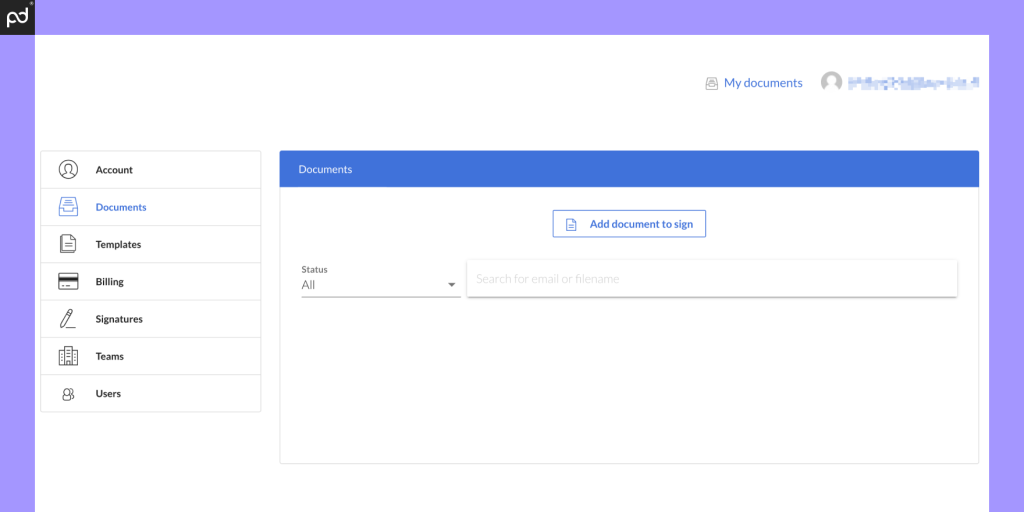
Cost: Professional (€9); Business (€15); Enterprise pricing available. Pricing based on monthly rate per single user.
Platform availability: Web (all devices).
Free trial: Yes; 14 days. Free account available.
| Plan Details | DocuSign | SignRequest |
|---|---|---|
| Plan Name | Business Pro | Business |
| Maximum seats on plan | 50 | Unlimited |
| Minimum seat on plan | – | – |
| Monthly rate (per month/user) | $65 | $16 |
| Annual rate (per month/user) | $40 | – |
| Transaction limits (per user) | 100 docs/year | Unlimited |
| Core product | ||
| E-signature capture | ✓ | ✓ |
| Real-time audit trail | ✓ | ✓ |
| Notifications | ✓ | ✓ |
| Language support | ✓ | ✓ |
| Mobile app | ✓ | X |
| Reporting tools | ✓ | X |
| E-signing features | ||
| Signing order | ✓ | ✓ |
| Send to multiple recipients | ✓ | ✓ |
| Bulk send | ✓ | $ |
| In-person signing | ✓ | ✓ |
| Collaboration tools | ✓ | X |
| Signer attachments | ✓ | ✓ |
| Payment gateway | ✓ | X |
| Document prep | ||
| Drag & drop fields (PDF) | ✓ | ✓ |
| Create reusable templates | ✓ | 5 |
| From-scratch document builder | X | X |
| Pre-built template library | X | X |
| Form creation | ✓ | X |
| Custom branding | ✓ | ✓ |
| Integrations & API | ||
| Import & storage | ✓ | ✓ |
| CRM | X | X |
| Productivity | ✓ | ✓ |
| API | $ | $ |
| Support | ||
| Email / ticketing support | ✓ | ✓ |
| Chat support | X | X |
| Knowledge base | ✓ | ✓ |
| Phone | X | X |
| Premium support options | $ | X |
Key features
- Offers the most cost-effective plans of any DocuSign competitor we reviewed.
- Custom branding, signer attachments, and bundled document sends are available in the basic plan.
One of the cheapest ways to access bulk send options, which rely on API credits (starting at €0.50 per document).
SignRequest is an e-signature software focused on providing a simple and straightforward signature solution for teams of every size.
Much like DocuSign, SignRequest allows users to upload a file, create fields on the document using a drag-and-drop tool, and email documents for a signature.
The biggest difference between SignRequest and many other services on our list comes down to cost.
At €9 per month for the Professional Plan, a single user has all the tools necessary to create legally-binding e-signatures for a relatively low cost.
Also unique to this platform is the abbreviated workflow. The SignRequest signature process takes place inside a single window.
You’ll upload the document, add your email contact and message, place your signature fields, and more all in one place.
By comparison, most signing tools walk users through three or four separate screens for this.
SignRequest handles almost everything without “next” buttons or additional page loads.
SignRequest users on the Business plan will also have access to API developer tools, but tokens are sold separately at around €0.50 per document.
Regarding sending and transaction limits: It’s also worth mentioning that the number of documents you can send falls under a “fair use” policy, which SignRequest determines based on the average of all accounts.
High volume sending, which is defined as “more than twice the average volume of all SignRequest customers” requires an add-on plan.
However, you (the sender) won’t actually know what those limits are, because SignRequest doesn’t publicly define them.
SignRequest even offers a free plan for users who are only sending a few documents each month and don’t mind SignRequest branding on their content.
SignRequest’s low price makes it competitive among most other digital signature solutions on our list.
If you’re just looking for a way to capture signatures quickly and don’t need any specialized tools or features, this app is a great place to start.
7. Signeasy
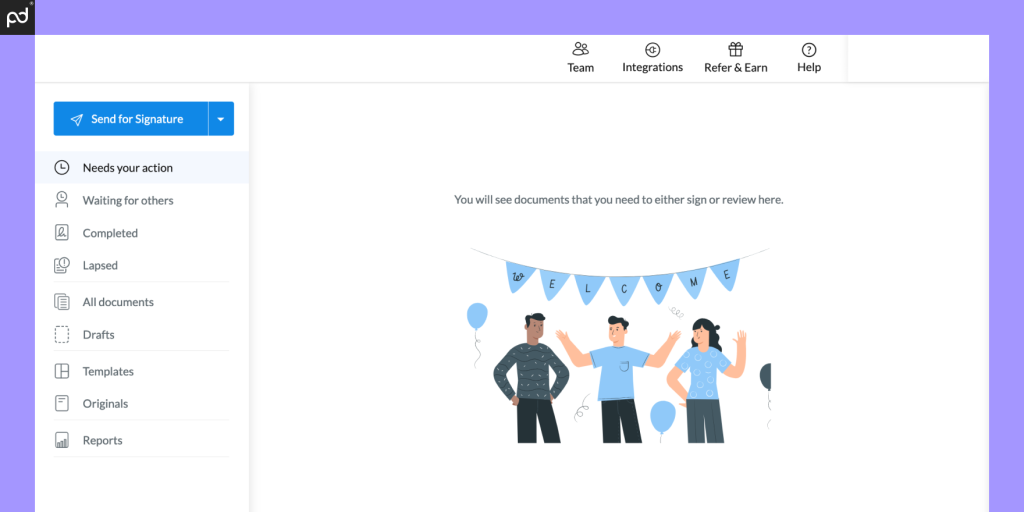
Cost: Personal ($10); Business ($20); Business Pro ($30). Per-document pricing available. Pricing based on monthly rate per single user.
Platform availability: Web (all devices); mobile app (iOS/Android).
Free trial: Yes; 14-days.
| Plan Details | DocuSign | SignEasy |
|---|---|---|
| Plan Name | Business Pro | Business Plus |
| Maximum seats on plan | 50 | Unlimited |
| Minimum seat on plan | – | – |
| Monthly rate (per month/user) | $65 | $60 |
| Annual rate (per month/user) | $40 | $50 |
| Transaction limits (per user) | 100 docs/year | Unlimited |
| Core product | ||
| E-signature capture | ✓ | ✓ |
| Real-time audit trail | ✓ | ✓ |
| Notifications | ✓ | ✓ |
| Language support | ✓ | ✓ |
| Mobile app | ✓ | ✓ |
| Reporting tools | ✓ | ✓ |
| E-signing features | ||
| Signing order | ✓ | ✓ |
| Send to multiple recipients | ✓ | ✓ |
| Bulk send | ✓ | API only |
| In-person signing | ✓ | ✓ |
| Collaboration tools | ✓ | Limited |
| Signer attachments | ✓ | ✓ |
| Payment gateway | ✓ | X |
| Document prep | ||
| Drag & drop fields (PDF) | ✓ | ✓ |
| Create reusable templates | ✓ | Unlimited |
| From-scratch document builder | X | X |
| Pre-built template library | X | ✓ |
| Form creation | ✓ | X |
| Custom branding | ✓ | ✓ |
| Integrations & API | ||
| Import & storage | ✓ | ✓ |
| CRM | X | Limited |
| Productivity | ✓ | ✓ |
| API | $ | $ |
| Support | ||
| Email / ticketing support | ✓ | ✓ |
| Chat support | X | ✓ |
| Knowledge base | ✓ | ✓ |
| Phone | X | ✓ |
| Premium support options | $ | X |
Key features
- Supports 25+ document types and offers a variety of signing methods — including offline signing.
- Limited integrations and lack of payment gateway forces reliance on third-party systems and solutions.
- Robust support options compared to DocuSign support.
As a DocuSign alternative, SignEasy supports multiple industries by providing compatibility to a wide array of file formats.
The platform promotes its e-signature service compliance with ESIGN and UETA, elDAS, and Aadhaar-based eSign.
While this isn’t exclusive to SignEasy (PandaDoc offers a similar level of compliance, as do most other signing tools), it’s good to know that the legally binding signatures provided by the platform will hold up to legal scrutiny.
SignEasy also offers some desirable features, like offline electronic signing and in-person signature collection, access from any device, a digital audit trail for users, and the ability for signers to attach supporting documents.
However, the plans come with a few downsides, particularly with the lack of payment and CRM integrations, and the lack of DocuSign’s bulk send option without an API plan.
While the platform offers native integrations with Microsoft Teams, Outlook, and Google Workspace, it doesn’t offer much in the way of CRM integrations aside from HubSpot and Salesforce (costs an additional $20/month).
Further, the offer for unlimited document signing may be something of a misnomer due to the “fair use” restrictions that aren’t clearly defined in their terms of service.
While this probably won’t be a major issue for most users, be aware that SignEasy reserves the right to limit sends and API usage for any time at their sole discretion.
This platform offers robust support options, including chat, email, and phone support, as well as a knowledge base and a dedicated CSM on higher-end plans.
8. OneSpan Sign (formerly eSignLive)
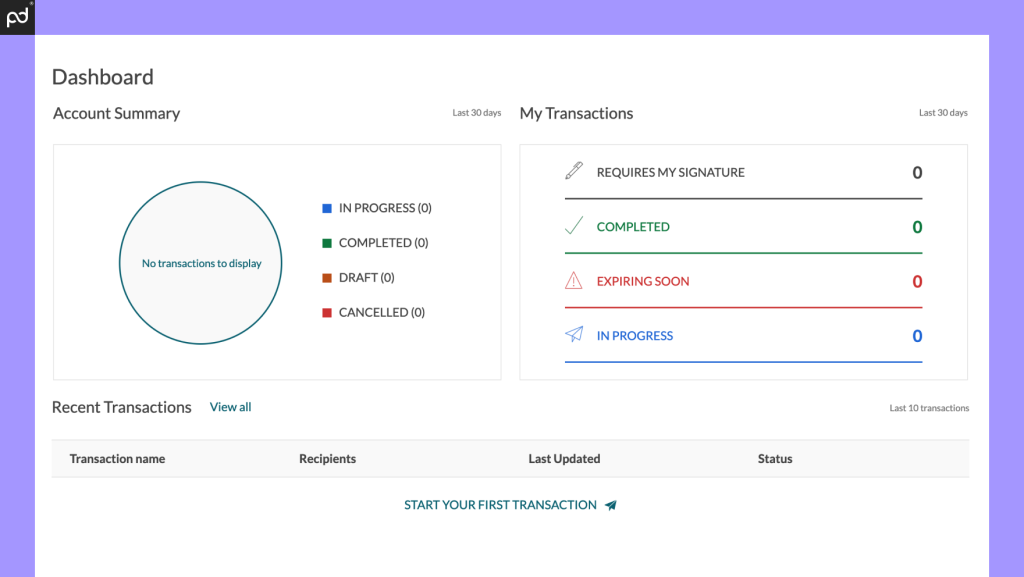
Cost: Professional Plan ($22). Annual commitment required. Enterprise plans available. Pricing per single user.
Platform availability: Web (all devices); mobile app (iOS/Android).
Free trial: No; Demo only.
| Plan Details | DocuSign | OneSpan Sign |
|---|---|---|
| Plan Name | Standard | Professional |
| Maximum seats on plan | 50 | 50 |
| Minimum seat on plan | – | – |
| Monthly rate (per month/user) | $45 | – |
| Annual rate (per month/user) | $25 | $22 |
| Transaction limits (per user) | 100 docs/year | 1000/year |
| Core product | ||
| E-signature capture | ✓ | ✓ |
| Real-time audit trail | ✓ | ✓ |
| Notifications | ✓ | ✓ |
| Language support | ✓ | ✓ |
| Mobile app | ✓ | ✓ |
| Reporting tools | ✓ | ✓ |
| E-signing features | ||
| Signing order | ✓ | ✓ |
| Send to multiple recipients | ✓ | ✓ |
| Bulk send | X | $ |
| In-person signing | ✓ | ✓ |
| Collaboration tools | ✓ | X |
| Signer attachments | X | ✓ |
| Payment gateway | X | X |
| Document prep | ||
| Drag & drop fields (PDF) | ✓ | ✓ |
| Create reusable templates | ✓ | ✓ |
| From-scratch document builder | X | X |
| Pre-built template library | X | X |
| Form creation | X | X |
| Custom branding | ✓ | ✓ |
| Integrations & API | ||
| Import & storage | ✓ | Limited |
| CRM | X | $ |
| Productivity | ✓ | Limited |
| API | $ | Enterprise only ($) |
| Support | ||
| Email / ticketing support | ✓ | ✓ |
| Chat support | X | X |
| Knowledge base | ✓ | ✓ |
| Phone | X | X |
| Premium support options | $ | Enterprise only ($) |
Key features
- Offers 1000 documents sent per year, compared to the 100/year limit from DocuSign.
- Combined with strong identity assurance software to ensure that signers are who they say they are.
- Offers open API and SDKs for fast integrations (Enterprise Plans only.
OneSpan Sign is focused on offering legally binding and compliant digital signatures alongside a fantastic user experience for senders, signers, and administrators.
The company highlights its globally distributed servers and its transparent, cost-effective solution, as well as comprehensive auditing, as its major selling points.
Like many of the DocuSign alternatives on our list, OneSpan Sign gets the basics right. However, the platform follows a relatively linear signing process.
It’s not possible to create advanced workflows or generate team or public comments on a document.
OneSpan Sign offers e-Signature solutions and some limited integrations.
For Enterprise Plans, an API and SDK solution for enterprise-level brands who want to white label OneSpan Sign and repackage it as part of their own product.
That’s important, because this solution is clearly targeted toward developers and teams who want to operate at a large scale using the API integrations and other identity-based solutions that the OneSpan brand.
Based on that information, we feel that OneSpan sign is a great contender for larger businesses and will excel in environments where it can be deployed at scale.
Smaller companies may be able to make use of the Professional Plan, but they may feel more at home with similar services offered by other platforms.
9. eSignly
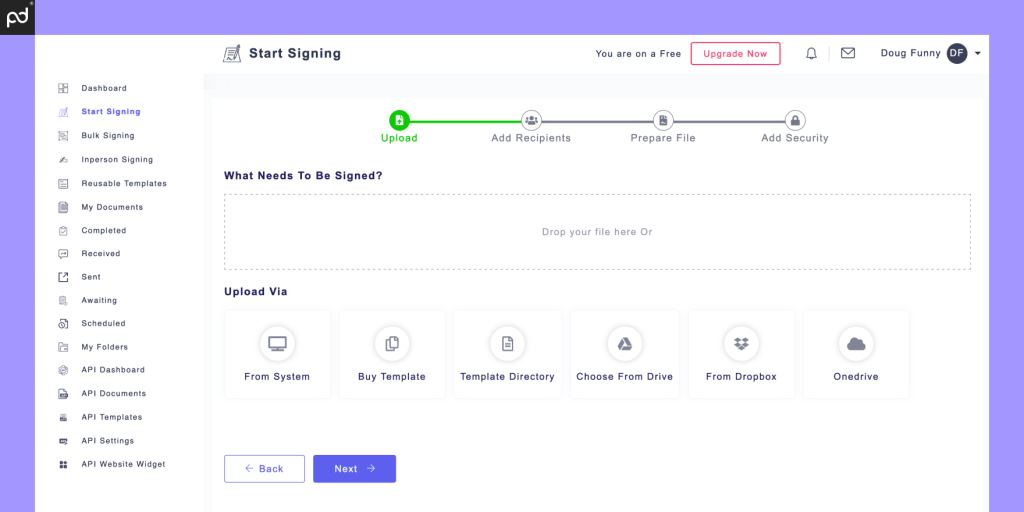
Cost: Professional ($15); Business ($25); Enterprise ($40). Pricing based on monthly rate per single user.
Platform availability: Web (all devices); mobile app (iOS/Android).
Free trial: Yes; 30 days. Free account available.
| Plan Details | DocuSign | eSignly |
|---|---|---|
| Plan Name | Business Pro | Enterprise |
| Maximum seats on plan | 50 | Unlimited |
| Minimum seat on plan | – | – |
| Monthly rate (per month/user) | $65 | $40 |
| Annual rate (per month/user) | $40 | $30 |
| Transaction limits (per user) | 100 docs/year | Unlimited |
| Core product | ||
| E-signature capture | ✓ | ✓ |
| Real-time audit trail | ✓ | ✓ |
| Notifications | ✓ | ✓ |
| Language support | ✓ | ✓ |
| Mobile app | ✓ | ✓ |
| Reporting tools | ✓ | ✓ |
| E-signing features | ||
| Signing order | ✓ | ✓ |
| Send to multiple recipients | ✓ | ✓ |
| Bulk send | ✓ | ✓ |
| In-person signing | ✓ | ✓ |
| Collaboration tools | ✓ | ✓ |
| Signer attachments | ✓ | ✓ |
| Payment gateway | ✓ | X |
| Document prep | ||
| Drag & drop fields (PDF) | ✓ | ✓ |
| Create reusable templates | ✓ | 15 Templates |
| From-scratch document builder | X | X |
| Pre-built template library | X | $ |
| Form creation | ✓ | X |
| Custom branding | ✓ | ✓ |
| Integrations & API | ||
| Import & storage | ✓ | Limited |
| CRM | X | Limited |
| Productivity | ✓ | X |
| API | $ | Limited |
| Support | ||
| Email / ticketing support | ✓ | ✓ |
| Chat support | X | X |
| Knowledge base | ✓ | X |
| Phone | X | X |
| Premium support options | $ | X |
Key features
- Plan pricing is based on user roles; possible to construct interesting plan configurations to save money.
- Built with team configurations in mind, allowing each plan tier to have a role in your organization.
- Templates are limited on every plan other than Enterprise.
If you’re looking for a fast and affordable electronic signature solution, eSignly is one of the best for cost. The user-friendly interface makes document signing a breeze.
One thing that we really like about eSignly is that — unlike other e-signature solutions — it’s not trying to be more than what it is: a fast and easy way to sign documents.
One of the big standouts for eSignly has to do with its pricing structure. Many pricing plans require that all team members be on the same plan in order to work together.
With eSignly, you can save money by pricing out plans based on user roles.
While your team administrator will need access to the Business plan, other team members can stay on the Pro or Free plan and work together with everyone else.
This is great for those team members who don’t need as much authority or administrative power but still need to be connected to the group.
eSignly’s straightforward product offering, as well as its unique take on pricing, easily put it on our list.
Plus, eSignly may feel like a minimalist solution for teams wanting to do more with their documents than simply collect e-signatures. But if that’s your only goal, they’re a great, low-cost option.
Lastly, while the team configuration options are unique, you might find the platform short on other essentials.
The platform has little to offer in the way of integrations on the e-signing plan.
Instead, integrations are handled through API add-ons and require a separate subscription plan.
While this won’t be a drawback if you’re trying to keep your signing workflow centralized to eSignly, it can hamper productivity if you’re accustomed to handing documents seamlessly between CRM apps and other productivity tools.
10. Xodo Sign (formerly eversign)
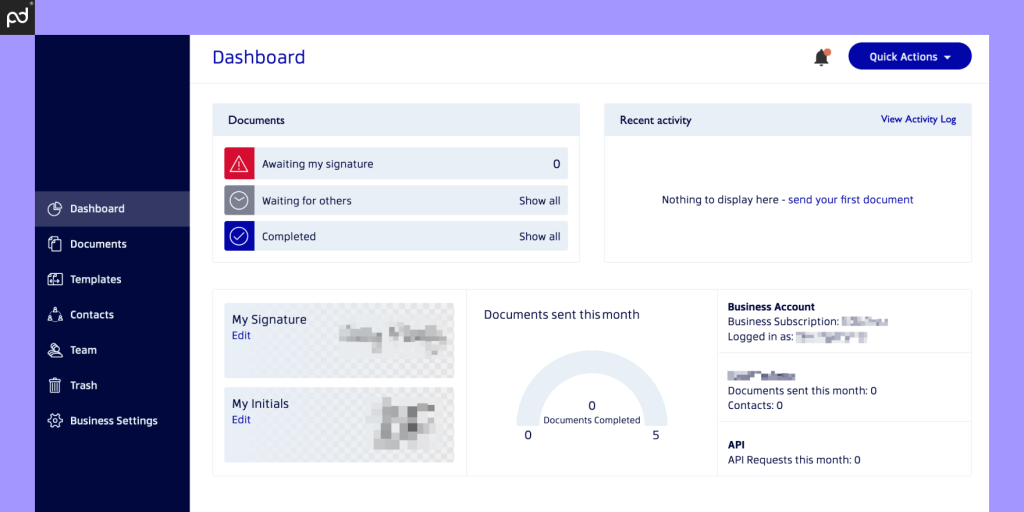
Cost: Basic ($9.99); Professional ($39.99); Professional plus ($99.99). Enterprise plans available. Pricing based on monthly rate per single user.
Platform availability: Web (all devices).
Free trial: Yes; 7 days. Free plan also available.
| Plan Details | DocuSign | Xodo Sign |
|---|---|---|
| Plan Name | Business Pro | Professional Plus |
| Maximum seats on plan | 50 | 15 |
| Minimum seat on plan | – | – |
| Monthly rate (per month/user) | $65 | $100 |
| Annual rate (per month/user) | $40 | $80 |
| Transaction limits (per user) | 100 docs/year | Unlimited |
| Core product | ||
| E-signature capture | ✓ | ✓ |
| Real-time audit trail | ✓ | ✓ |
| Notifications | ✓ | ✓ |
| Language support | ✓ | ✓ |
| Mobile app | ✓ | X |
| Reporting tools | ✓ | X |
| E-signing features | ||
| Signing order | ✓ | ✓ |
| Send to multiple recipients | ✓ | ✓ |
| Bulk send | ✓ | API only |
| In-person signing | ✓ | ✓ |
| Collaboration tools | ✓ | X |
| Signer attachments | ✓ | X |
| Payment gateway | ✓ | X |
| Document prep | ||
| Drag & drop fields (PDF) | ✓ | ✓ |
| Create reusable templates | ✓ | 25 Templates |
| From-scratch document builder | X | X |
| Pre-built template library | X | X |
| Form creation | ✓ | X |
| Custom branding | ✓ | ✓ |
| Integrations & API | ||
| Import & storage | ✓ | ✓ |
| CRM | X | ✓ |
| Productivity | ✓ | ✓ |
| API | $ | Limited |
| Support | ||
| Email / ticketing support | ✓ | ✓ |
| Chat support | X | X |
| Knowledge base | ✓ | ✓ |
| Phone | X | X |
| Premium support options | $ | X |
Key features
- Offers core e-signing features and unlimited document sends from the basic level to enterprise.
- Templates, API calls, and team members are capped across almost every plan.
- Includes SMS credits in every plan for users who want to notify signers via text.
A popular signing platform for both personal and professional users, Xodo Sign (formerly eversign) is great if you’re looking for a no-nonsense plan with a handful of interesting features.
The paid plans remove the sending limits attached to the free plan (five documents/month) and will give you access to templates, API tools, and app integrations for better automation.
However, above the basic tier, Xodo Sign moves in an entirely different direction from DocuSign.
Where DocuSign offers reporting and collaboration tools at higher tiers, Xodo Sign moves to offer app integrations, API documents, and other interesting features.
While unique, this also creates something of a gap between the two platforms.
At the same tier, DocuSign offers reporting and collaboration tools that you simply won’t see in Xodo Sign.
Though these tools aren’t truly document analytics, in the way that PandaDoc uses them, they are a leg up over what Xodo Sign is equipped to offer.
DocuSign’s business plans tend to add more features while Xodo Sign scales with additional users.
The Xodo Sign Basic plan supports one team member, while the Professional and Professional Plus plans support five and 15 team members, respectively.
You’ll also get additional SMS signing credits, and the ability to automate more documents and create additional custom templates.
For users interested in automation, the native API access is where Xodo Sign really shines.
DocuSign offers API plans separately, starting at $75/month for a 40 envelope/month package.
With Xodo Sign, you’ll have a preset API send limit as part of your standard plan. The platform also offers separate API plans if you need additional credits.
If you’re looking to get your feet wet with API tools without paying an extra fee or onboarding to an additional plan, Xodo Sign is a great starting point.
11. Foxit eSign (formerly eSign Genie)
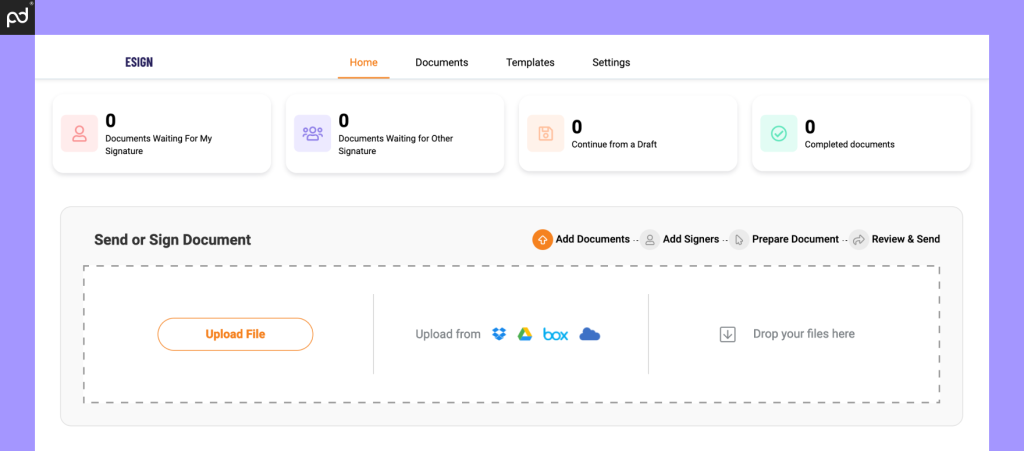
Cost: eSign ($96); eSign Pro ($300). Enterprise plans available. Pricing based on annual document allocation. Plan expires after one year or when the transaction limit is reached.
Platform availability: Web (all devices); mobile app (iOS/Android).
Free trial: Yes; 14-days.
| Plan Details | DocuSign | Foxit eSign |
|---|---|---|
| Plan Name | Standard | eSign Pro |
| Maximum seats on plan | 50 | 1 |
| Minimum seat on plan | – | – |
| Monthly rate (per month/user) | $45 | – |
| Annual rate (per month/user) | $25 | $25 |
| Transaction limits (per user) | 100 docs/year | 500/year |
| Core product | ||
| E-signature capture | ✓ | ✓ |
| Real-time audit trail | ✓ | ✓ |
| Notifications | ✓ | ✓ |
| Language support | ✓ | Limited |
| Mobile app | ✓ | ✓ |
| Reporting tools | ✓ | ✓ |
| E-signing features | ||
| Signing order | ✓ | ✓ |
| Send to multiple recipients | ✓ | ✓ |
| Bulk send | X | X |
| In-person signing | ✓ | X |
| Collaboration tools | ✓ | X |
| Signer attachments | X | ✓ |
| Payment gateway | X | X |
| Document prep | ||
| Drag & drop fields (PDF) | ✓ | ✓ |
| Create reusable templates | ✓ | 50 |
| From-scratch document builder | X | X |
| Pre-built template library | X | X |
| Form creation | X | ✓ |
| Custom branding | ✓ | ✓ |
| Integrations & API | ||
| Import & storage | ✓ | ✓ |
| CRM | X | X |
| Productivity | ✓ | ✓ |
| API | $ | X |
| Support | ||
| Email / ticketing support | ✓ | ✓ |
| Chat support | X | X |
| Knowledge base | ✓ | ✓ |
| Phone | X | ✓ |
| Premium support options | $ | X |
Key features
- Plan purchase is based on annual transaction limits. This plan expires after a year or if the transaction limit is reached before the expiry date.
- Offers signable web forms, signer attachments, HIPAA compliance, and other features at a lower cost when compared to DocuSign.
- Includes integration options (Zapier, WordPress, Google Workspace) without requiring an enterprise plan.
Foxit eSign (formerly eSign Genie) has always had a robust product offering that outshines DocuSign in several ways.
Like DocuSign, Foxit offers basic notifications, multi-language signing, audit trails, and mobile compatibility.
However, they offer so much more than the basics — even on their basic plan!
Users switching from DocuSign to Foxit will still follow similar steps during document preparation.
You’ll load your PDF into the cloud, add text boxes and similar fields within the document editor, and send the document.
But you’ll also be able to add attachments, automatically cancel signatures, and use conditional logic when creating documents.
On higher-tier plans, you’ll be able to facilitate in-person signing, equip your sent documents with custom branding, and even create online forms — something that DocuSign just doesn’t do outside of PowerForms — and embed them into websites and applications.
You’ll also be able to get help when you need it.
DocuSign offers paid support plans separately from its main product line.
Without those plans, users can get support by submitting a ticket and waiting for a reply, but it can be hours or days before someone gets in touch.
By comparison, Foxit users gain access to 24/7 phone support, so help is always just a phone call away.
On the other hand, one of the biggest downsides to this plan comes with how the plan limitations are structured.
DocuSign users have a cap of 100 envelopes/year for each user. Foxit follows suit by limiting transactions, but the difference is in the way the caps are implemented.
DocuSign will still continue to function if you exceed your send limit, and you’ll need to work with the sales team to find pricing that works for your needs.
Foxit offers a higher annual envelope limit, but the plan stops working when you hit that threshold.
Once the cap is reached, you’ll need to renew your subscription early to get another set of envelopes.
In our view, the larger envelope limits far outweigh the downsides, but this is something you’ll need to keep an eye on if you go with Foxit.
Of course, you could also avoid transaction limits entirely by working with a platform that doesn’t implement envelope limits or sending thresholds.
12. YouSign
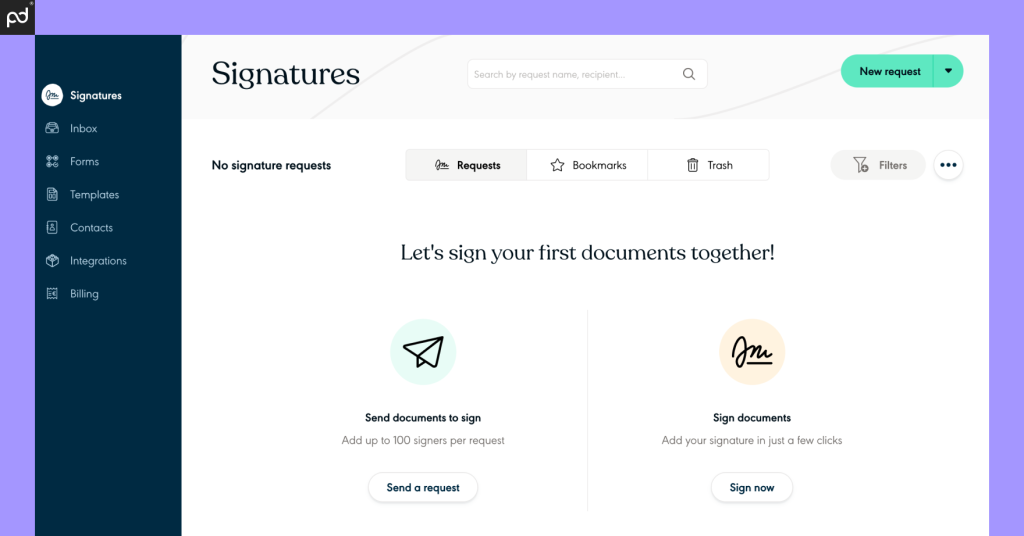
Cost: One (€11); Plus (€30); Pro (€48). Enterprise pricing available. Pricing based on monthly rate per single user.
Platform availability: Web (all devices); mobile app (iOS/Android).
Free trial: Yes; 14 days. Also offers a free account.
| Plan Details | DocuSign | YouSign |
|---|---|---|
| Plan Name | Business Pro | Pro |
| Maximum seats on plan | 50 | Unlimited |
| Minimum seat on plan | – | – |
| Monthly rate (per month/user) | $65 | $51 |
| Annual rate (per month/user) | $40 | $43 |
| Transaction limits (per user) | 100 docs/year | Unlimited |
| Core product | ||
| E-signature capture | ✓ | ✓ |
| Real-time audit trail | ✓ | ✓ |
| Notifications | ✓ | ✓ |
| Language support | ✓ | ✓ |
| Mobile app | ✓ | X |
| Reporting tools | ✓ | X |
| E-signing features | ||
| Signing order | ✓ | ✓ |
| Send to multiple recipients | ✓ | ✓ |
| Bulk send | ✓ | ✓ |
| In-person signing | ✓ | ✓ |
| Collaboration tools | ✓ | ✓ |
| Signer attachments | ✓ | X |
| Payment gateway | ✓ | X |
| Document prep | ||
| Drag & drop fields (PDF) | ✓ | ✓ |
| Create reusable templates | ✓ | Unlimited |
| From-scratch document builder | X | X |
| Pre-built template library | X | X |
| Form creation | ✓ | $ |
| Custom branding | ✓ | ✓ |
| Integrations & API | ||
| Import & storage | ✓ | ✓ |
| CRM | X | Limited |
| Productivity | ✓ | Limited |
| API | $ | X |
| Support | ||
| Email / ticketing support | ✓ | ✓ |
| Chat support | X | X |
| Knowledge base | ✓ | ✓ |
| Phone | X | ✓ |
| Premium support options | $ | X |
Key features
- Advanced electronic signature tools are only available as add-ons for the Plus and Pro plans. (Important for EU customers looking for eIDAS-compliant signing.)
- In-person signing is available on all plans (including Free), so you can always sign documents face-to-face.
- Offers some basic integration tools (Salesforce, HubSpot, Zapier), but native connectivity is limited.
Based in Europe, YouSign bills itself as the go-to e-signature solution designed for SMBs.
While the company offers a variety of plans with a wide selection of features that immediately set it apart from DocuSign, we first need to address their e-signature offering.
The European Union relies on eIDAS to define electronic signature standards.
These legal requirements are clear on how electronic signatures are classified and break signatures down into three main categories (more on that here).
By default, YouSign offers “Simple eSignatures”, which are the most basic form of e-signing.
While they are legally binding in many instances, basic e-signatures lack the additional security measures found in Advanced Electronic Signatures (AES) and Qualified Electronic Signatures (QES).
Why does this matter?
Because most companies, including DocuSign and PandaDoc, offer identification information that will support AES signature verification by default.
This information is captured each time a document is signed, regardless of your signing plan.
According to their plan information, YouSign only offers the same level of authentication as an add-on to their Plus and Pro plans.
If security and authenticity is critical for your documents, as is often the case for business contracts, YouSign might be a great option if you’re willing to pay for the add-ons.
Aside from that hurdle, YouSign offers several features of note.
As part of the initial plan, you’ll have access to in-person signing, something that DocuSign doesn’t offer until you reach the Standard plan at $45/month.
You’ll also have the ability to add attachments and custom branding to your send your documents from the start, both of which are features that are only available on higher-tiered DocuSign plans.
API access is available, but it’s a separate plan and isn’t included as part of the standard application pricing.
13. Formstack Sign
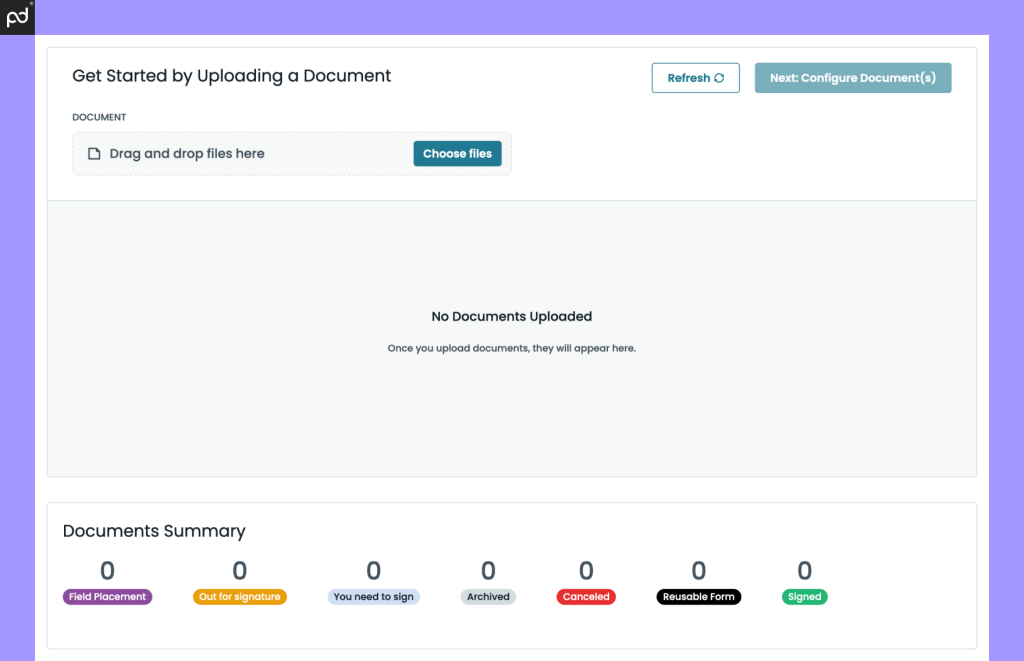
Cost: Forms ($83); Suite ($250). Enterprise pricing available. Pricing based on monthly rate per single user.
Platform availability: Web (all devices).
Free trial: Yes; 14 days.
| Plan Details | DocuSign | Formstack |
|---|---|---|
| Plan Name | Personal | Sign |
| Maximum seats on plan | 1 | – |
| Minimum seat on plan | – | – |
| Monthly rate (per month/user) | $15 | $20 |
| Annual rate (per month/user) | $10 | $18 |
| Transaction / envelope limits | 5/month | Unlimited |
| Core product | ||
| E-signature capture | ✓ | ✓ |
| Real-time audit trail | ✓ | ✓ |
| Notifications | ✓ | ✓ |
| Language support | ✓ | X |
| Mobile app | ✓ | X |
| Reporting tools | ✓ | Limited |
| E-signing features | ||
| Signing order | ✓ | ✓ |
| Send to multiple recipients | ✓ | ✓ |
| Bulk send | X | X |
| In-person signing | X | ✓ |
| Collaboration tools | X | ✓ |
| Signer attachments | X | X |
| Payment gateway | X | X |
| Document prep | ||
| Drag & drop fields (PDF) | ✓ | ✓ |
| Create reusable templates | ✓ | ✓ |
| From-scratch document builder | X | X |
| Pre-built template library | X | X |
| Form creation | X | X |
| Custom branding | X | ✓ |
| Integrations & API | ||
| Import & storage | ✓ | X |
| CRM | X | X |
| Productivity | X | X |
| API | $ | X |
| Support | ||
| Email / ticketing support | ✓ | ✓ |
| Chat support | X | X |
| Knowledge base | ✓ | ✓ |
| Phone | X | X |
| Premium support options | $ | X |
Key features
- Affordable e-signing solutions with room to expand into document and form creation.
- Automated signing workflows and approval tools for fast and easy document management.
- Some attractive features are withheld and given to other products in the Formstack lineup to encourage bundled purchases.
Formstack Sign provides an excellent, no-nonsense signing service that works with any file type.
Using this tool, you’ll have access to basic branding — even at the entry-level — and the ability to create unlimited documents and templates to send for unlimited signatures.
That’s important because DocuSign omits these features in their lower-tier plans.
As you move into plans designed for larger teams, you’ll have access to advanced branding features, API access, custom data retention protocols, and quite a bit more.
The battery of features on offer, all of which are centered around an improved e-signing experience, makes Formstack Sign a formidable DocuSign alternative.
However, it’s worth pointing out that Formstack Sign is just one in a family of products that includes Formstack Documents and Formstack Forms.
As a result, some of the features that you might see in other competitive tools like PandaDoc or GetAccept aren’t available in Formstack Sign.
You’d need to subscribe to the entire Formstack platform, which raises the price significantly.
On top of that, Formstack splits its Salesforce integrations into entirely separate plans.
Salesforce Native Plans are designed specifically for use inside of Salesforce and offer a different set of features and signing tools.
However, these tools are exclusive to those plans and aren’t available on the Core pricing plans.
14. GetAccept
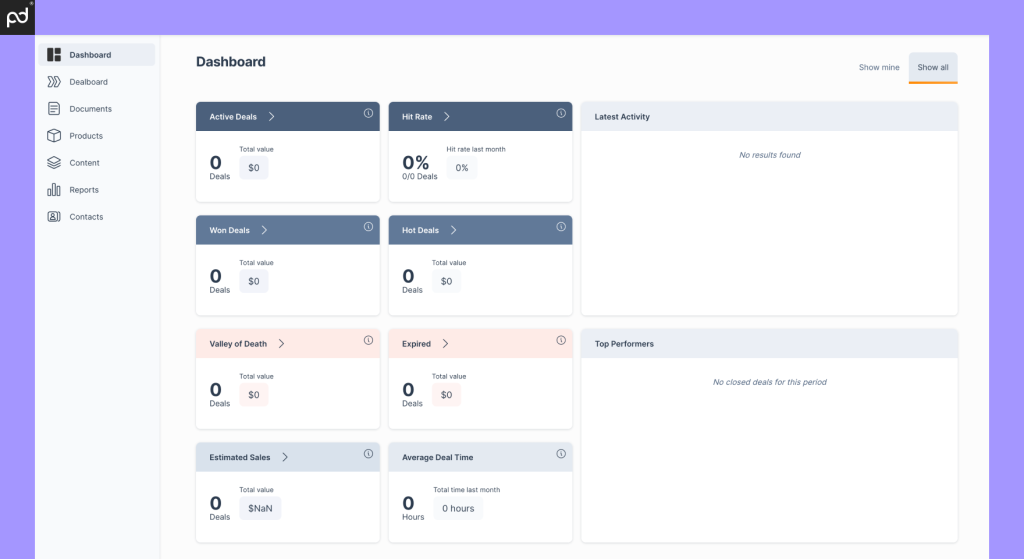
Cost: Essential ($15); Deal Room ($39); Contract Room ($49) Full Suite ($79). Enterprise pricing available for each category. Pricing based on monthly rate per single user.
Platform availability: Web (all devices); mobile app (iOS/Android).
Free trial: Yes; 14 days. Also offers a free account.
| Plan Details | DocuSign | GetAccept |
|---|---|---|
| Plan Name | Business Pro | Full Suite |
| Maximum seats on plan | 50 | Unlimited |
| Minimum seat on plan | – | – |
| Monthly rate (per month/user) | $65 | $49 |
| Annual rate (per month/user) | $40 | – |
| Transaction limits (per user) | 100 docs/year | Unlimited |
| Core product | ||
| E-signature capture | ✓ | ✓ |
| Real-time audit trail | ✓ | ✓ |
| Notifications | ✓ | ✓ |
| Language support | ✓ | ✓ |
| Mobile app | ✓ | ✓ |
| Reporting tools | ✓ | ✓ |
| E-signing features | ||
| Signing order | ✓ | ✓ |
| Send to multiple recipients | ✓ | ✓ |
| Bulk send | ✓ | X |
| In-person signing | ✓ | X |
| Collaboration tools | ✓ | ✓ |
| Signer attachments | ✓ | ✓ |
| Payment gateway | ✓ | $ |
| Document prep | ||
| Drag & drop fields (PDF) | ✓ | ✓ |
| Create reusable templates | ✓ | ✓ |
| From-scratch document builder | X | Limited |
| Pre-built template library | X | ✓ |
| Form creation | ✓ | Limited |
| Custom branding | ✓ | ✓ |
| Integrations & API | ||
| Import & storage | ✓ | ✓ |
| CRM | X | $ |
| Productivity | ✓ | $ |
| API | $ | $ |
| Support | ||
| Email / ticketing support | ✓ | X |
| Chat support | X | ✓ |
| Knowledge base | ✓ | ✓ |
| Phone | X | X |
| Premium support options | $ | X |
Key features
- Healthy mix of e-signing and sales tools make this platform ideal for users looking for a more sales-oriented solution.
- Robust free and intermediate plans make this platform a good fit for users trying to keep costs low.
- Plan setup is somewhat convoluted. In total, GetAccept offers seven pricing plans split across four editions/categories.
GetAccept is more of a digital sales platform than a simple e-signing solution — although you’ll find that electronic signatures are very much a part of this digital workspace.
Much like PandaDoc, GetAccept allows you to do more with your documents than just have them signed.
However, where PandaDoc is focused on document generation and management as part of the sales process, GetAccept tries to create a complete buying experience with video and live chat functionality, dashboards, and collaborative, virtual workspaces.
As you might expect, e-signing with GetAccept is just one small portion of the feature set.
This is a major deviation from DocuSign, where electronic signature capture is the entire point of the software.
Using GetAccept, you can upload files or create documents from scratch using the onboard document editor. (While we found this feature somewhat limited, it’s possible to build documents with it.)
Once a document is uploaded to the workspace, the GetAccept platform becomes a salesroom where customers can review documentation, ask questions, and collaboratively interact with you to get deals across the finish line with an electronic signature.
The tricky part with GetAccept is figuring out which plan makes the most sense for you.
Three of the four configurations also offer an enterprise version, so the upgrade path isn’t linear.
GetAccept’s Full Suite plan is the most comprehensive — combining features from both Deal Room and Contract Room — but it’s also possible to get an enterprise version of the lower-tier plans.
Overall, the GetAccept platform will give you the tools to elevate your sales cycle, and e-signing is a part of that.
15. DocSend
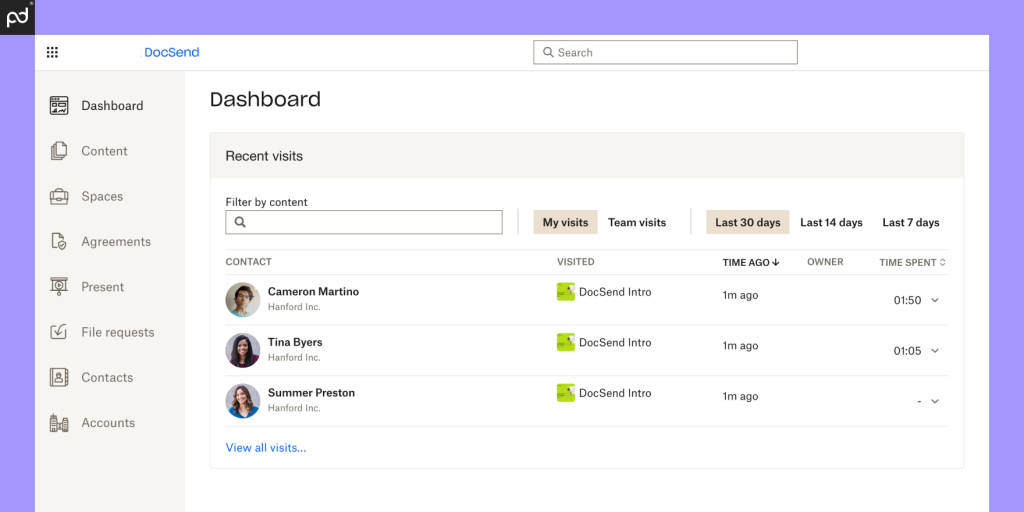
Cost: Personal ($15); Standard ($65); Advanced ($250/month, incl. three seats). Enterprise pricing available. Pricing based on minimum monthly seat requirements.
Platform availability: Web (all devices).
Free trial: Yes; 14 days.
| Plan Details | DocuSign | DocSend |
|---|---|---|
| Plan Name | Business Pro | Advanced |
| Maximum seats on plan | 50 | Unlimited |
| Minimum seat on plan | – | 3 |
| Monthly rate (per month/user) | $65 | $250 / month |
| Annual rate (per month/user) | $40 | $150 / month |
| Transaction limits (per user) | 100 docs/year | Unlimited |
| Core product | ||
| E-signature capture | ✓ | ✓ |
| Real-time audit trail | ✓ | ✓ |
| Notifications | ✓ | ✓ |
| Language support | ✓ | ✓ |
| Mobile app | ✓ | X |
| Reporting tools | ✓ | ✓ |
| E-signing features | ||
| Signing order | ✓ | X |
| Send to multiple recipients | ✓ | Max 10 |
| Bulk send | ✓ | X |
| In-person signing | ✓ | X |
| Collaboration tools | ✓ | ✓ |
| Signer attachments | ✓ | via File Requests |
| Payment gateway | ✓ | X |
| Document prep | ||
| Drag & drop fields (PDF) | ✓ | ✓ |
| Create reusable templates | ✓ | X |
| From-scratch document builder | X | X |
| Pre-built template library | X | X |
| Form creation | ✓ | X |
| Custom branding | ✓ | ✓ |
| Integrations & API | ||
| Import & storage | ✓ | ✓ |
| CRM | X | $ |
| Productivity | ✓ | |
| API | $ | X |
| Support | ||
| Email / ticketing support | ✓ | ✓ |
| Chat support | X | ✓ |
| Knowledge base | ✓ | ✓ |
| Phone | X | ✓ |
| Premium support options | $ | X |
Key features
- Send, share, and sign documents while maintaining total control over file visibility and access.
- Branded document viewer and custom subdomain give you better control over the marketing experience for customers.
- Link-based sending features provide additional granular control over sharing and access.
When compared to DocuSign, DocSend by Dropbox is a unique platform that is focused more on safe sending and less on just getting a signature.
With that in mind, e-signatures are only one part of the DocSend toolkit, which is why it’s on the list.
So what’s the deal with DocSend?
Simply put, DocSend is an alternative to sending sensitive information in a way that forces you to give up control of your document.
Sending email attachments is a great example.
Once you send a file via email, that file is out in the wild forever.
You might update it or create additional versions, but someone will always have older versions in their inbox.
This can lead to confusion and frustration if documents undergo rapid changes, or if those documents contain sensitive information that needs to be protected.
With DocSend, those files will always stay under your control.
You can share access to them and decide whether you want to allow users to download them.
When needed, it’s also possible to revoke access or update your documents to the most current version without having to worry about dealing with version management.
E-signatures come into play for documents that need to be securely shared and signed.
You’ll get real-time signature notifications, the ability to create signable documents and self-serve forms, and more.
Pricing is competitive with DocuSign on the low end (limited features), but the Advanced and Enterprise
Plans may not make sense for users who don’t see the value in the other features that this platform provides.
16. DottedSign
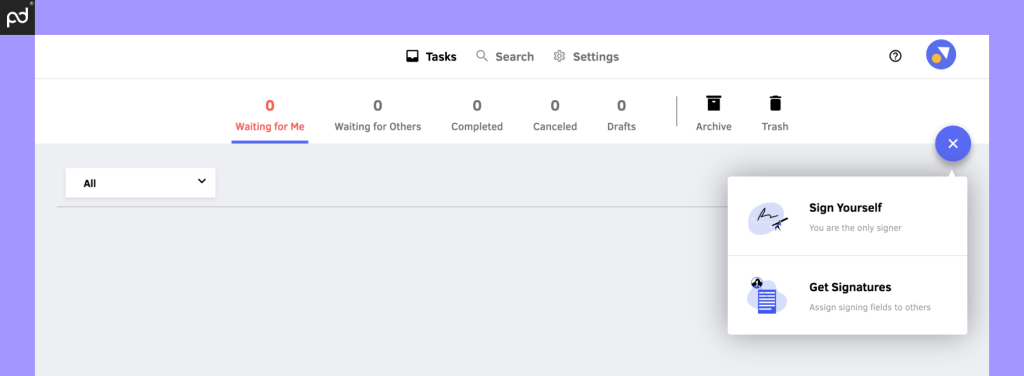
Cost: Pro ($15); Business $30); Enterprise plan available. Pricing based on monthly rate per single user.
Platform availability: Web (all devices); mobile app (iOS/Android).
Free trial: Yes; 14 days. Free plan available.
| Plan Details | DocuSign | DottedSign |
|---|---|---|
| Plan Name | Standard | Business |
| Maximum seats on plan | 50 | 50 |
| Minimum seat on plan | – | – |
| Monthly rate (per month/user) | $45 | $30 |
| Annual rate (per month/user) | $25 | $18 |
| Transaction limits (per user) | 100 docs/year | Unlimited |
| Core product | ||
| E-signature capture | ✓ | ✓ |
| Real-time audit trail | ✓ | ✓ |
| Notifications | ✓ | ✓ |
| Language support | ✓ | ✓ |
| Mobile app | ✓ | ✓ |
| Reporting tools | ✓ | X |
| E-signing features | ||
| Signing order | ✓ | ✓ |
| Send to multiple recipients | ✓ | ✓ |
| Bulk send | X | ✓ |
| In-person signing | ✓ | ✓ |
| Collaboration tools | ✓ | ✓ |
| Signer attachments | X | ✓ |
| Payment gateway | X | X |
| Document prep | ||
| Drag & drop fields (PDF) | ✓ | ✓ |
| Create reusable templates | ✓ | 30 Templates |
| From-scratch document builder | X | X |
| Pre-built template library | X | X |
| Form creation | X | X |
| Custom branding | ✓ | ✓ |
| Integrations & API | ||
| Import & storage | ✓ | ✓ |
| CRM | X | X |
| Productivity | ✓ | ✓ |
| API | $ | X |
| Support | ||
| Email / ticketing support | ✓ | ✓ |
| Chat support | X | X |
| Knowledge base | ✓ | ✓ |
| Phone | X | X |
| Premium support options | $ | X |
Key features
- Robust and streamlined signing solution offers strong value for comparatively low cost.
- Team reporting tools help managers review productivity but don’t include document engagement metrics.
- Limited native integrations force a reliance on Zapier or, at the Enterprise level, connecting via API.
As far as e-signing solutions go, DottedSign will check a lot of boxes for many users.
The platform offers a streamlined signing process and remains highly affordable while offering many services that more expensive software solutions charge extra to deliver.
The table above compares the DocuSign Standard plan to the highest pre-arranged DottedSign plan due solely to pricing.
DocuSign has more expensive plans with a larger feature set, but only for a much higher cost.
In order to get some features from DocuSign — like signer attachments and bulk sending — you’d need to pay roughly $65 for the Business Pro plan. Quite a difference!
Aside from the price difference, DottedSign offers quite a bit of overlap with DocuSign.
The signing platform follows a signing protocol that will be familiar to DocuSign users, so it’s easy to hop in and get started quickly.
However, as appealing as the cost and the signing flow might be, the biggest shortfall that the app experiences is the lack of integrations and advanced features available to users.
DottedSign is a great signing platform, but it doesn’t bring anything new or innovative to the table when compared to other e-signing tools.
If you’re looking for a low-cost DocuSign substitute, it’s a great match.
However, if you’re looking for e-signing tools that can elevate your sales workflow and document creation process, DottedSign won’t have much to offer.
17. CocoSign
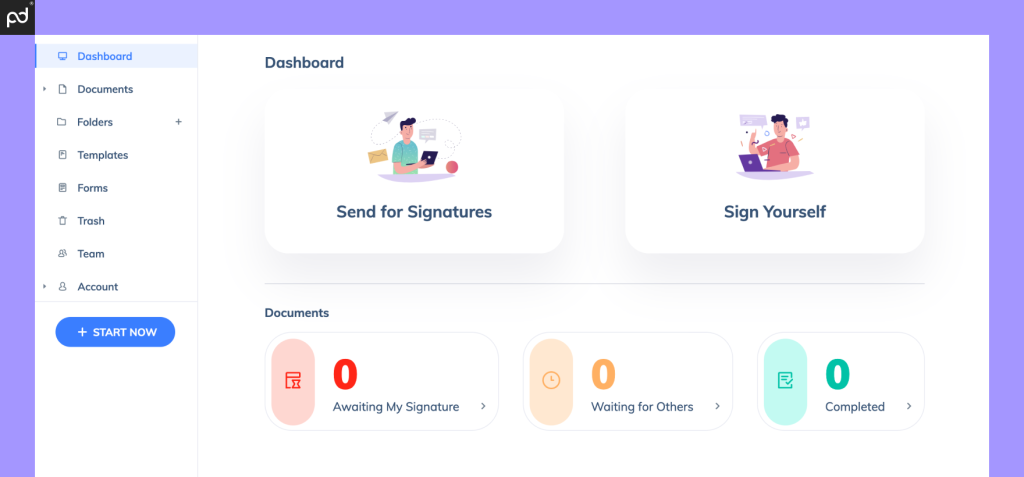
Cost: Essential ($12); Professional ($25); Business ($35). Enterprise pricing available. Pricing based on monthly rate per single user.
Platform availability: Web (all devices).
Free trial: Yes; 14 days. Free plan available.
| Plan Details | DocuSign | CocoSign |
|---|---|---|
| Plan Name | Business Pro | Business |
| Maximum seats on plan | 50 | Unlimited |
| Minimum seat on plan | – | – |
| Monthly rate (per month/user) | $65 | $35 |
| Annual rate (per month/user) | $40 | $25 |
| Transaction limits (per user) | 100 docs/year | Unlimited |
| Core product | ||
| E-signature capture | ✓ | ✓ |
| Real-time audit trail | ✓ | ✓ |
| Notifications | ✓ | ✓ |
| Language support | ✓ | X |
| Mobile app | ✓ | X |
| Reporting tools | ✓ | ✓ |
| E-signing features | ||
| Signing order | ✓ | ✓ |
| Send to multiple recipients | ✓ | ✓ |
| Bulk send | ✓ | ✓ |
| In-person signing | ✓ | ✓ |
| Collaboration tools | ✓ | X |
| Signer attachments | ✓ | ✓ |
| Payment gateway | ✓ | X |
| Document prep | ||
| Drag & drop fields (PDF) | ✓ | ✓ |
| Create reusable templates | ✓ | ✓ |
| From-scratch document builder | X | X |
| Pre-built template library | X | X |
| Form creation | ✓ | ✓ |
| Custom branding | ✓ | ✓ |
| Integrations & API | ||
| Import & storage | ✓ | ✓ |
| CRM | X | X |
| Productivity | ✓ | ✓ |
| API | $ | X |
| Support | ||
| Email / ticketing support | ✓ | X |
| Chat support | X | ✓ |
| Knowledge base | ✓ | ✓ |
| Phone | X | X |
| Premium support options | $ | X |
Key features
- Large selection of document management tools help you track and manage document flows with ease.
- Bulk sending is easy due to highly scalable interfaces.
- Audit history is clear, easy to locate, and downloadable so it’s easy to prove the chain of custody for every document.
Another solution available at relatively low cost compared to the major players in the space, CocoSign brings a high level of document management and organization to the e-signing process.
Like PandaDoc, CocoSign offers the ability to manage all of your documents through the platform interface.
If you’re on the Business plan, you can even create folders to assist with this process.
That’s assuming you don’t want to pair off with a cloud storage integration, which is an option that is available for all plans.
Much like DocuSign, CocoSign enables users to send multiple documents as part of a single package.
CocoSign calls this “Mass Document Sending,” but it’s really just the ability to combine all of your documents into one big send.
This can be done with DocuSign, with each send counting as an “envelope.” The big difference here is that CocoSign doesn’t limit users to 100 sends per year like DocuSign does.
Unfortunately, CocoSign falls short on integrations. The platform integrates with Google Drive and Microsoft 365.
It’s also possible to use Zapier to add some additional connectivity, but you won’t find native integrations for CRMs, sales tools, or most productivity software when using this app.
18. Signaturely
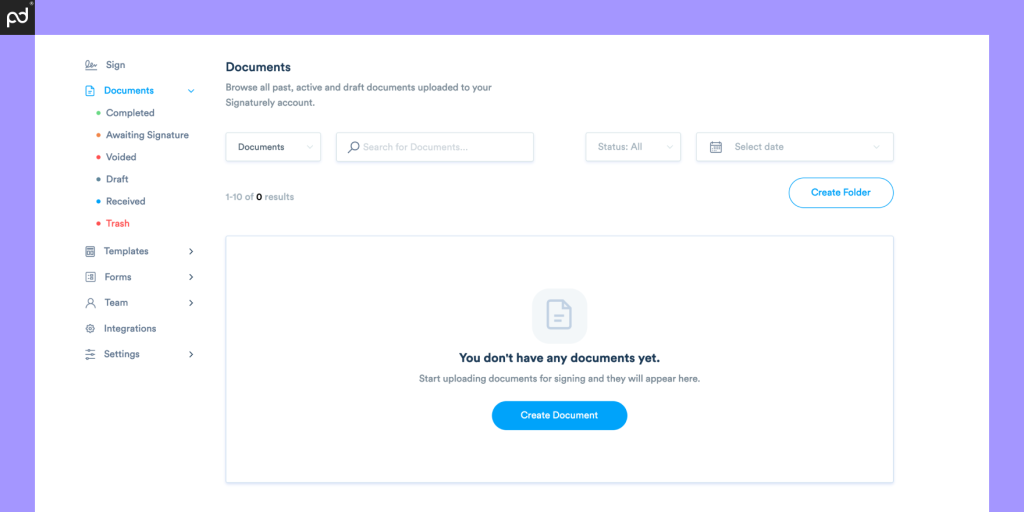
Cost: Personal ($20); Business ($40). Pricing based on monthly rate per single user.
Platform availability: Web (all devices).
Free trial: No. Free plan available.
| Plan Details | DocuSign | Signaturely |
|---|---|---|
| Plan Name | Business Pro | Business |
| Maximum seats on plan | 50 | Unlimited |
| Minimum seat on plan | – | – |
| Monthly rate (per month/user) | $65 | $40 |
| Annual rate (per month/user) | $40 | $32 |
| Transaction limits (per user) | 100 docs/year | Unlimited |
| Core product | ||
| E-signature capture | ✓ | ✓ |
| Real-time audit trail | ✓ | ✓ |
| Notifications | ✓ | ✓ |
| Language support | ✓ | X |
| Mobile app | ✓ | X |
| Reporting tools | ✓ | X |
| E-signing features | ||
| Signing order | ✓ | ✓ |
| Send to multiple recipients | ✓ | ✓ |
| Bulk send | ✓ | ✓ |
| In-person signing | ✓ | X |
| Collaboration tools | ✓ | X |
| Signer attachments | ✓ | X |
| Payment gateway | ✓ | X |
| Document prep | ||
| Drag & drop fields (PDF) | ✓ | ✓ |
| Create reusable templates | ✓ | ✓ |
| From-scratch document builder | X | X |
| Pre-built template library | X | X |
| Form creation | ✓ | ✓ |
| Custom branding | ✓ | ✓ |
| Integrations & API | ||
| Import & storage | ✓ | ✓ |
| CRM | X | X |
| Productivity | ✓ | X |
| API | $ | X |
| Support | ||
| Email / ticketing support | ✓ | ✓ |
| Chat support | X | ✓ |
| Knowledge base | ✓ | ✓ |
| Phone | X | X |
| Premium support options | $ | X |
Key features
- Simple signing solution allows for unlimited signature requests and includes notification and log history.
- Lack of an enterprise-level solution means that larger teams may get more for their money from other platforms.
- Pre-built template library can give you a headstart on building some basic documents, but templates are limited on all but the Business plan.
From the features on offer and the pricing structure, it’s very clear that Signaturely is aiming to provide a no-nonsense and streamlined solution that is easy to understand.
Aside from the limitations around templates and team management, all plans seem to offer the same benefits.
That includes bulk sending, activity tracking, and notifications. However, DocuSign users will see much more in terms of functionality for roughly the same cost.
While Signaturely does come with basic storage integrations and some team management tools, it’s hard to say whether these features are enough to offset the cost of the product compared to competitors.
Plus, the lack of an enterprise level plan means that larger teams are locked in at the Business plan with no way to scale up.
Similar to PandaDoc, Signaturely also offers premade templates.
Unfortunately, because the platform doesn’t offer a true document editor, it’s difficult to drastically change and modify the provided text.
These templates are great starting points, of course, but you may find that you ultimately need more flexibility than what the Signaturely editor can provide in order to make proper use of them.
Further, you won’t find much in the way of integrations, which is notable, considering that Signaturely’s Business plan is competitive with other DocuSign alternatives.
Aside from basic storage integrations, you won’t find many connectivity options.
Overall, this platform stays in its lane and does its job well … but you won’t find any surprises here.
Cheapest DocuSign alternatives
Although DocuSign pricing is affordable, there are some low-cost, DocuSign alternatives worth investigating if you’re on a tight budget:
1. DocHub
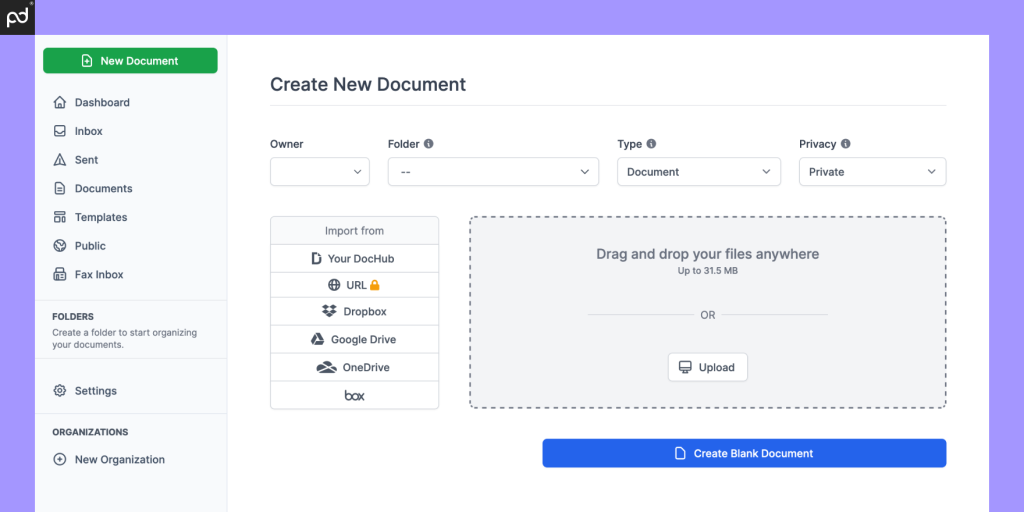
DocHub is largely set up for PDFs, featuring tools including online annotation and the ability to merge those types of files.
It also supports a wide range of formats including DOC, PPT, XLS, TXT, and DOCX.
This platform (full review here)offers a simple drag-and-drop interface for creating docs and forms.
The software works on desktop and mobile, with every edit automatically saved to the cloud.
It’s good for collaboration, as you can set permissions for others to edit and sign, or make a document public.
The only integrations are Google and Dropbox, and DocHub doesn’t have some of the more advanced tools that programs like DocuSign or PandaDoc can provide.
For example, payment collection, document analytics, and custom branding are absent in this platform.
DocHub has a free plan, which allows for five self signatures and three sign requests per month.
The Pro plan costs $10/month/user and features unlimited documents, e-signatures, and sign requests.
Both allow access to “premium tools” including customized stamps, rasterizing documents, and priority tech support.
2. Indy
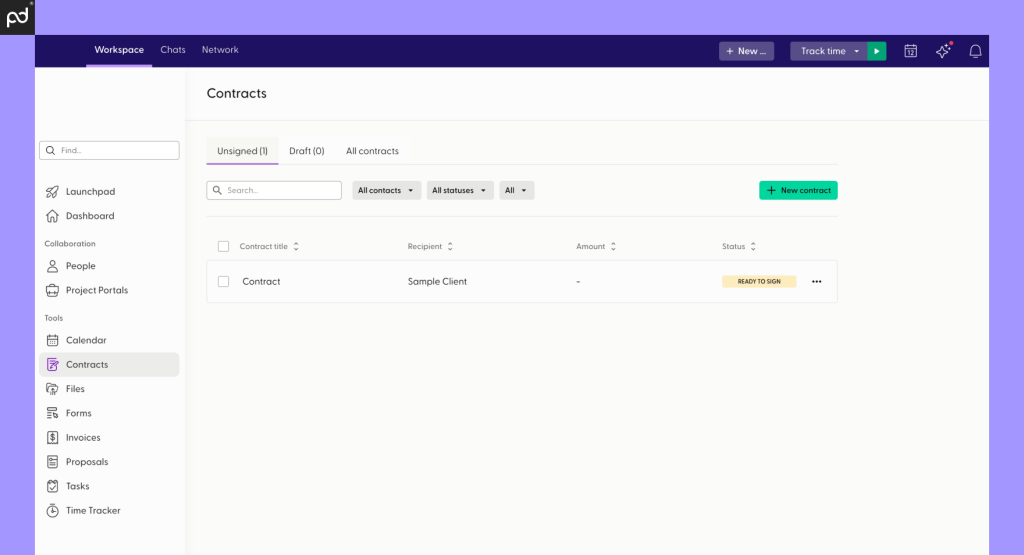
Indy is an all-in-one tool for managing a freelance business. That does include creating proposals, contracts, and invoices — with electronic signature functionality.
You can auto-generate signatures from text or upload from your computer, and store them for re-use. Clients can sign online without an Indy account.
There’s a list of freelance professions such as copywriting, photography, and accounting, with one template for each.
You can comment on docs or upload new versions, and monitor statuses via a dashboard.
Other tools include basic CRM, payment collection, calendars, and time tracking.
There’s a very basic free plan and a Pro tier for $4.49/month/user.
All features at that level are unlimited, except for storage which is set at 500GB. The only customer support is via chat (office hours, PST time zone only).
3. Fill
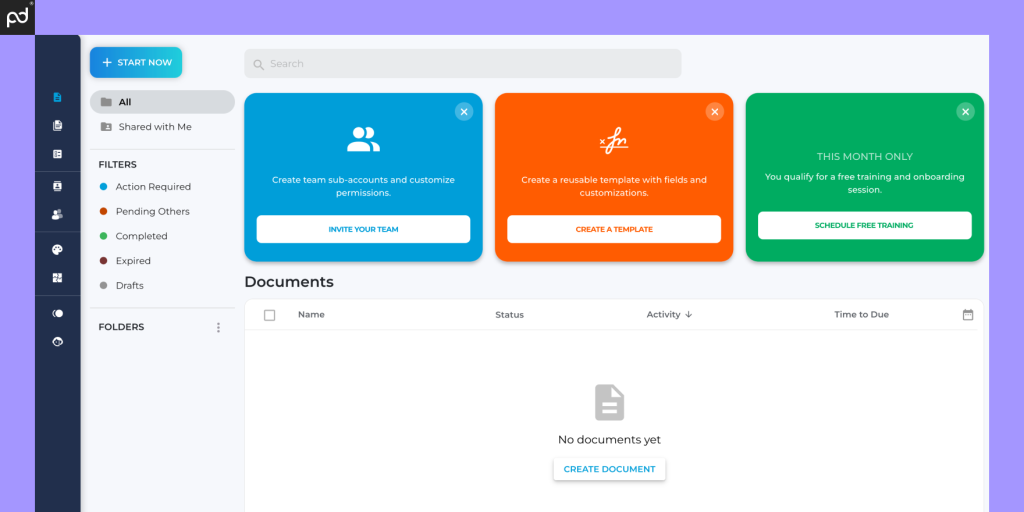
Fill is an e-signature and contract management software that works on any device, enabling team collaboration for creating documents and forms online.
You can send and collect signatures from customers in real time via email and text message, and get notified when a recipient annotates or signs.
You can also Import documents or customize templates with drag-and-drop editing and speed up workflows with reusable templates and sharing links to fillable forms.
The biggest asset in Fill is smart document filling, which is provided in every plan, including the free plan. You also get audit trails and real-time analytics.
The free plan has unlimited eSignature requests and uploads. Paid tiers are Basic (personal use) for $8.33/month; Plus $16.67; and Pro $24.99.
All are for a single license apart from Pro, where you can add more. Secure encryption and HIPAA compliance don’t kick in until the top tier.
How we sourced our data
Gathering all the required information for an article like this is no easy feat!
To create an accurate comparison between these e-signing tools, we relied on the data provided by the e-signing platforms themselves, including each of the following:
- Pricing pages.
- Support hubs.
- Website feature pages.
Where possible, our team also created temporary and trial accounts to test and verify these features firsthand.
This hands-on testing gave us a better understanding of DocuSign, its competitors, and how these e-signature tools differentiate themselves from one another.
Finally, we (rarely) relied upon scoring and ranking tools from independent third parties like G2 and/or Gartner to guide our decisions around coverage and gather additional information on the user experience.
The analysis surrounding each tool is a product of our own experience, and our interpretation of the product advantages/limitations we noted during our live testing and review of the given platform.
What’s the best alternative to DocuSign?
Because of how e-signing technology has evolved, apps like DocuSign are more common now than they were a decade ago.
There are also cheaper alternatives to DocuSign that offer similar feature sets and advanced features to streamline the e-signing process.
The 18 DocuSign alternatives on our list are some of the best e-signing providers on the market.
However, the best way to figure out which one suits your needs is to take it for a test drive.
Most of the e-signature solutions that we’ve discussed today offer a free trial or a free version so you can easily find the perfect solution for your business.
If you’ve only ever used DocuSign, you might be surprised to find that e-signing workflows and software like what DocuSign offers are quite common.
In our opinion, you’ll hardly do better than PandaDoc.
While we’re the first ones to admit that it’s hard to be objective in these cases, PandaDoc is the only solution on this list that offers extensive features.
You’ll have unlimited documents to send, professionally designed templates for any purpose, as well as numerous integrations with the most popular software out there.
Frequently asked questions
-
DocuSign is similar to many other electronic signature software tools, in that it enables you and your clients to exchange legally-binding signatures for business documents without having to send paperwork in the mail.
This makes life easier for remote workforces and companies whose clients are distributed across the globe.
You can upload documents in various formats from your computer or file-sharing sites, and keep them stored and managed in one secure place.
This could include sales proposals, vendor contracts, invoices, and new hire documentation.
You can add standard fields like signatures and dates to your agreements, and apply them in reusable templates to save time and standardize your processes. DocuSign doesn’t have a native document creation function, although you can generate docs via integration with Salesforce.
-
Yes. Many modern e-signing solutions are better alternatives to DocuSign, depending on your needs and preferences.
The send and envelope limits that DocuSign imposes can hamper your ability to send documentation in a way that makes sense for your business.
Many companies, including PandaDoc, have removed such restrictions so that sending documentation is faster, easier, and can be accomplished without worrying about arbitrary overages.
DocuSign performs well as part of a tech stack by offering many connections and integrations — including obscure connections that many other companies don’t offer.
However, between Zapier and native integrations offered by DocuSign competitors, you can probably find a way to integrate your preferred e-signing solution with other popular productivity tools.
-
The electronic signature market is always shifting.
Currently, the biggest DocuSign competitors are other major e-signing hubs like Acrobat Sign, Dropbox Sign, and PandaDoc.
Each of these companies offers a more holistic approach to e-signing and may offer a variety of interesting features to stand apart from the DocuSign platform.
For example, Acrobat Sign gives you the ability to natively edit PDFs while Dropbox Sign offers additional storage as part of the signup process.
Meanwhile, PandaDoc offers the best native document creation platform on the market, allowing you to create contracts, proposals, and other business documents completely from scratch.
-
No.
While it’s possible to e-sign documents using Microsoft Word’s digital signing certificates, Microsoft doesn’t have a native electronic signature solution similar to DocuSign.
However, Microsoft does offer native compatibility with DocuSign and companies similar to it, including Acrobat Sign, by building that functionality directly into the user interface.
It’s also possible to use integration tools like the PandaDoc for Word add-in to connect better and cheaper DocuSign alternatives directly to your word processor.
-
Somewhat.
Google is (slowly) rolling out a new e-signing feature to Google Workspace customers that allows users to prepare and send PDFs for e-signing.
This feature allows users to place signing fields in a document and features an audit trail, which generates after all signatures are captured and the document is finalized.
However, this feature is new and not yet widely available, making it difficult to evaluate as a viable DocuSign alternative.
Disclaimer
Parties other than PandaDoc may provide products, services, recommendations, or views on PandaDoc’s site (“Third Party Materials”). PandaDoc is not responsible for examining or evaluating such Third Party Materials, and does not provide any warranties relating to the Third Party Materials. Links to such Third Party Materials are for your convenience and does not constitute an endorsement of such Third Party Materials.
Originally published November 12, 2020, updated March 26, 2024
